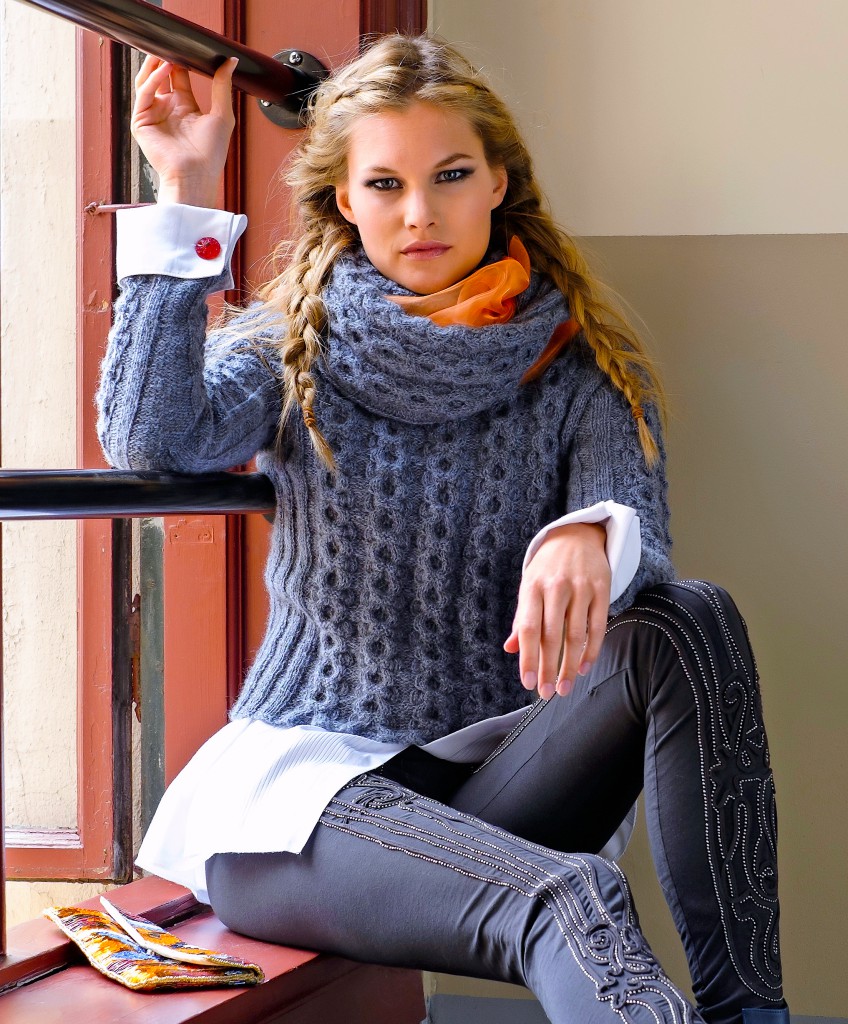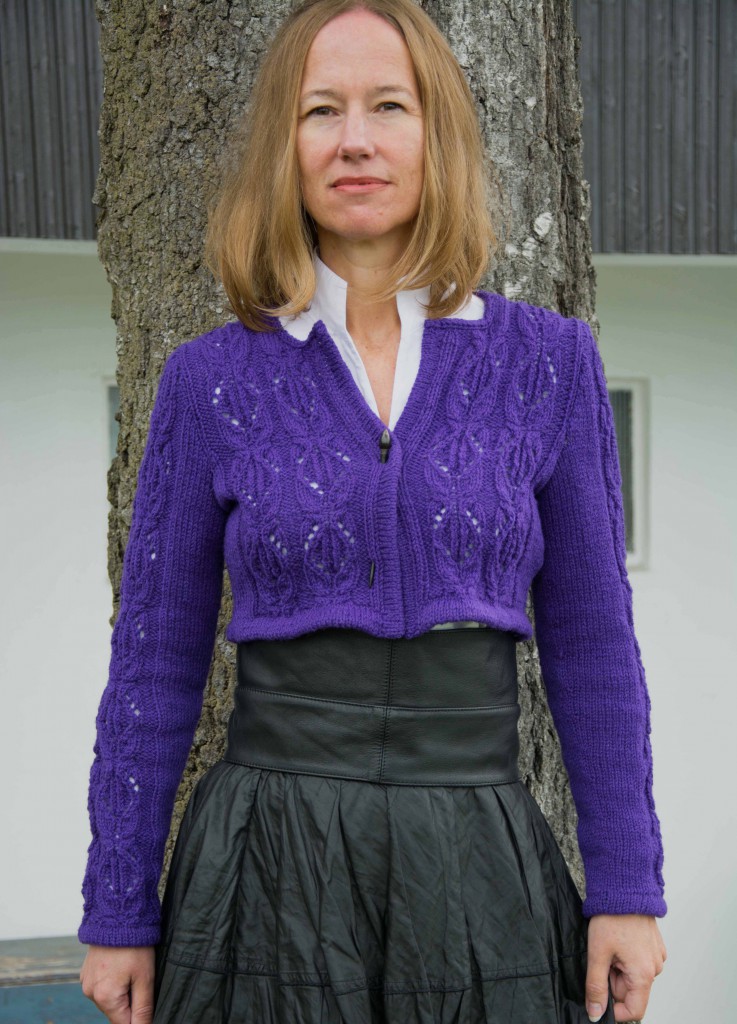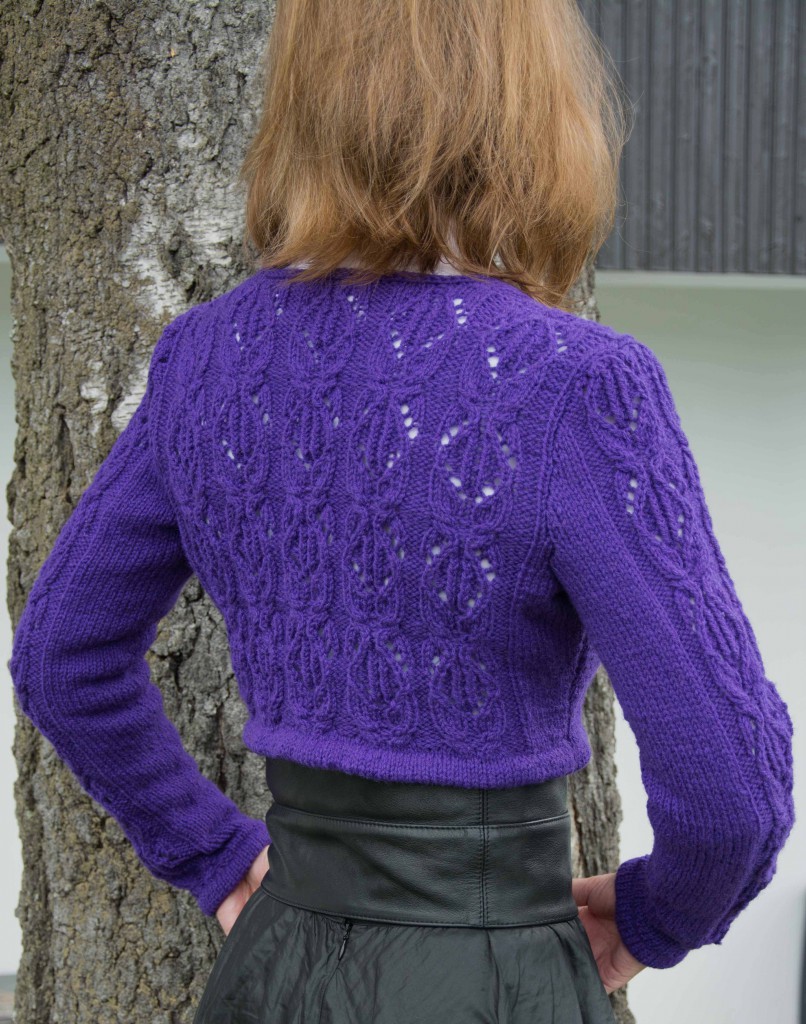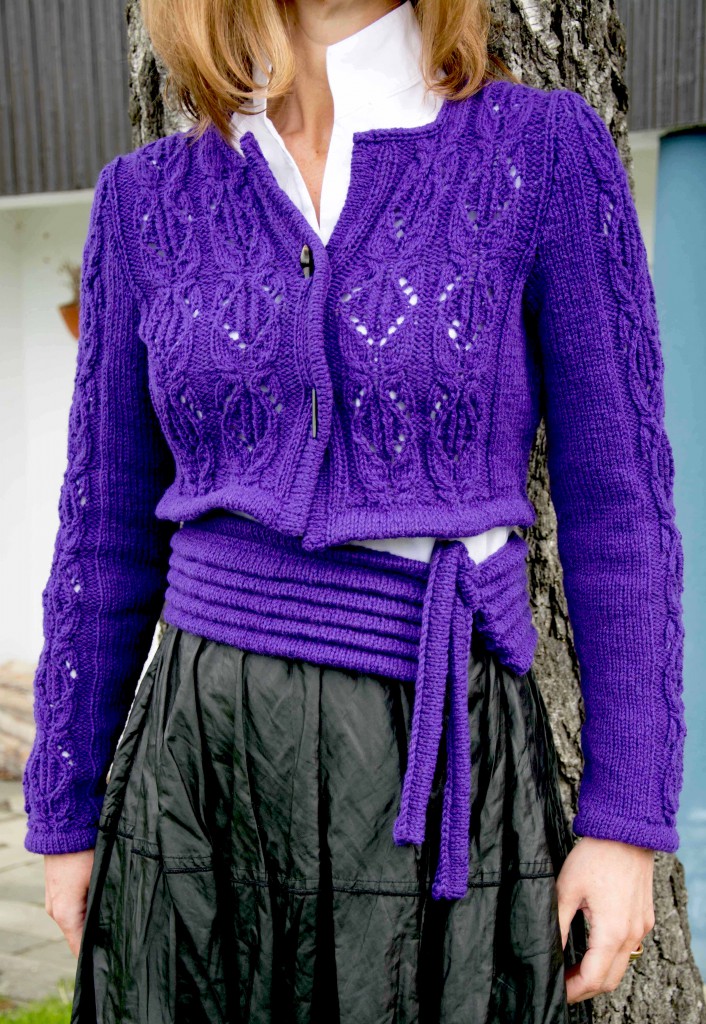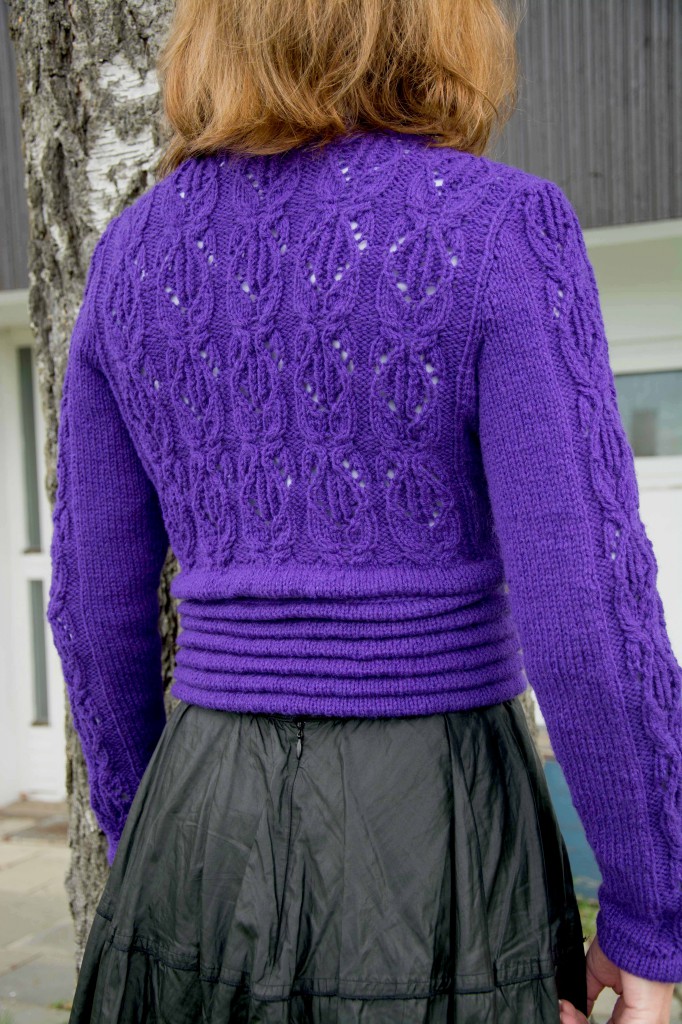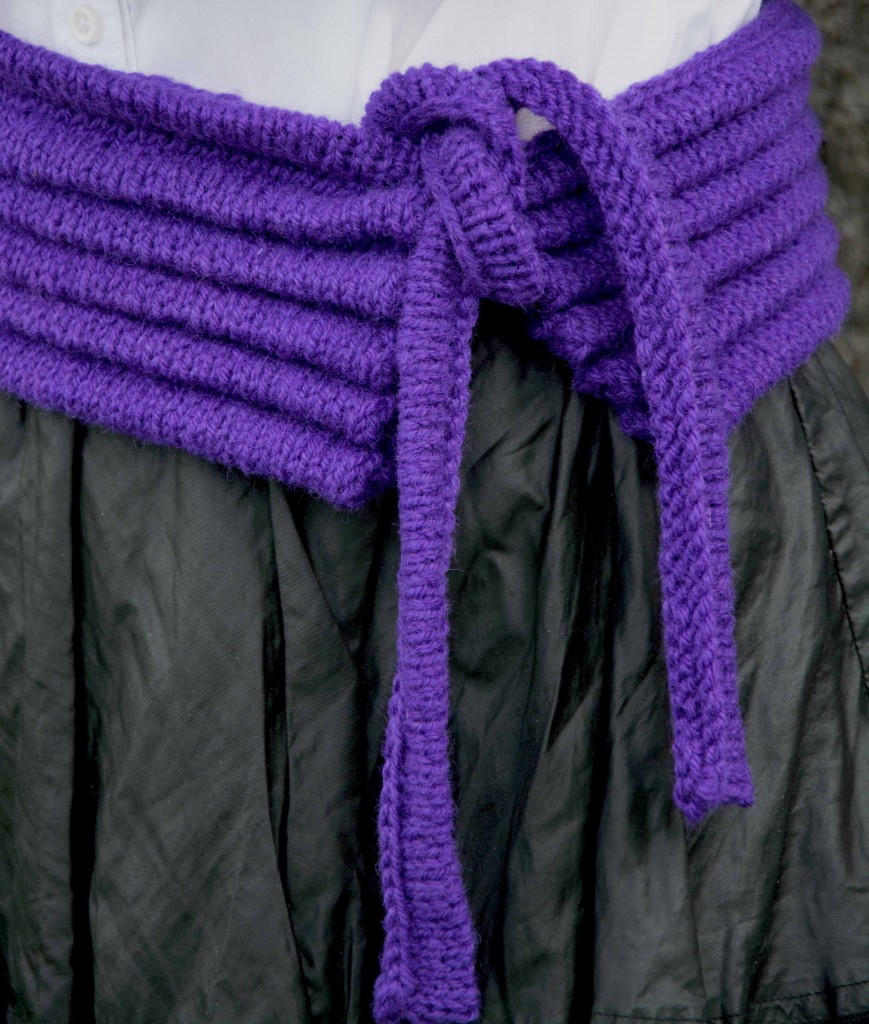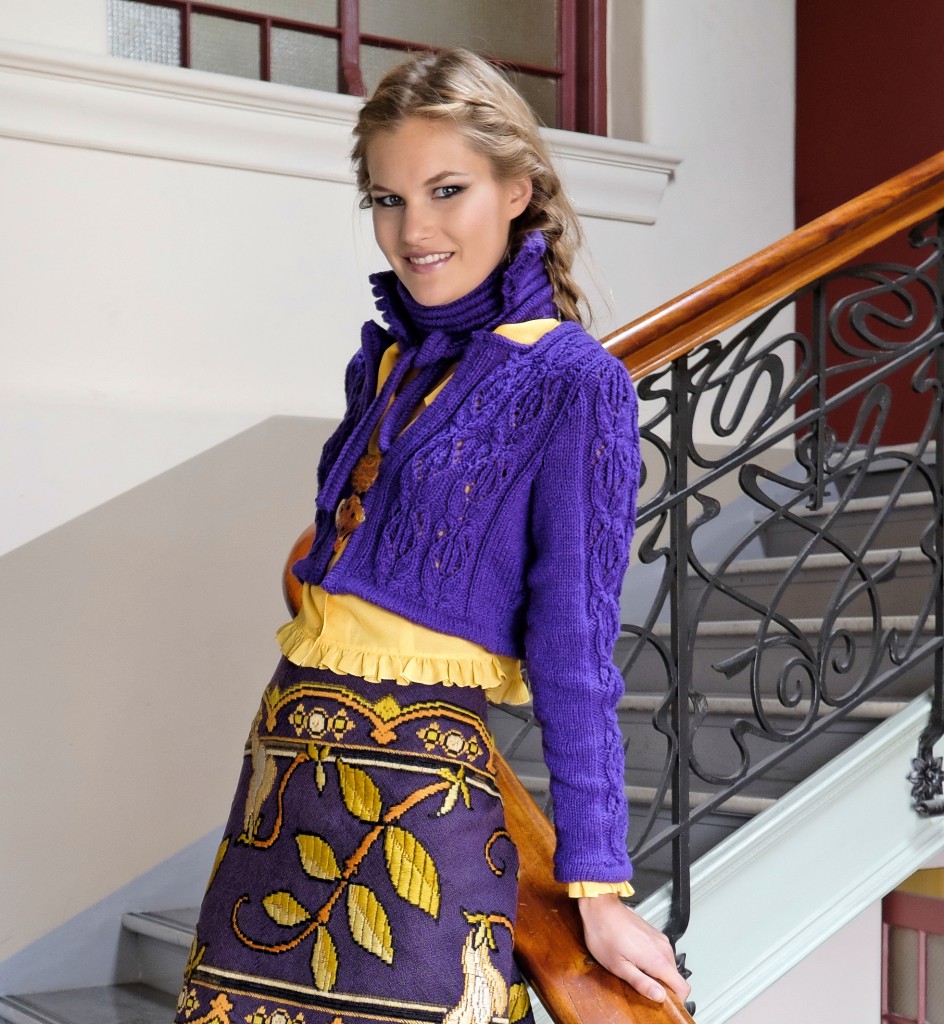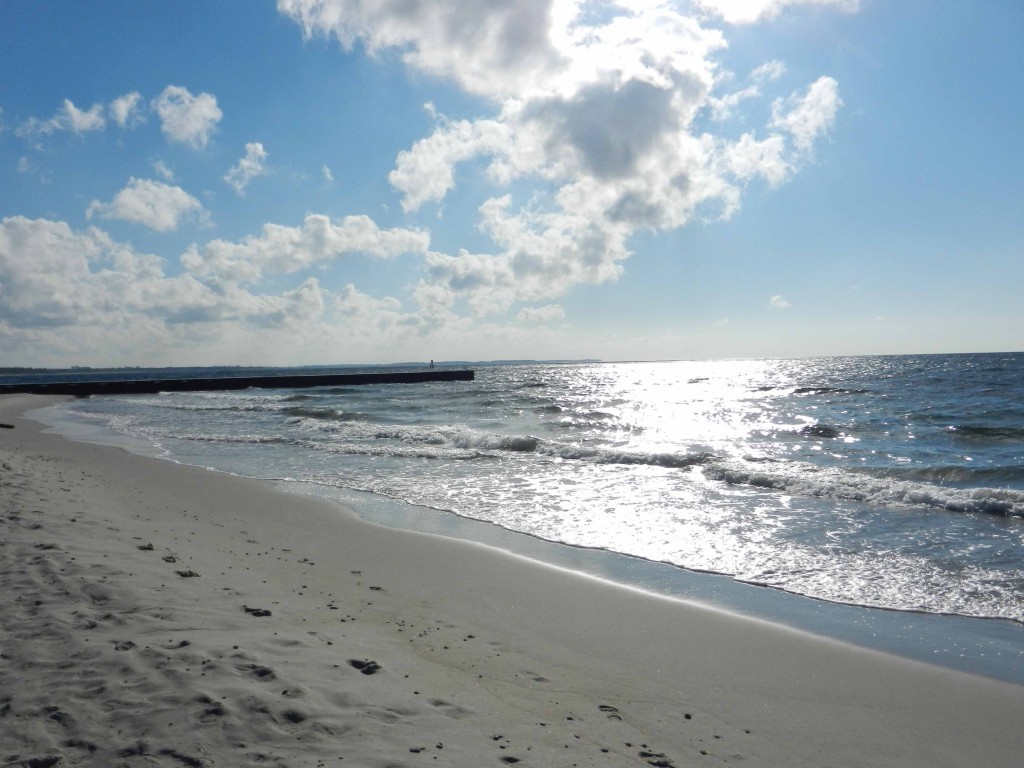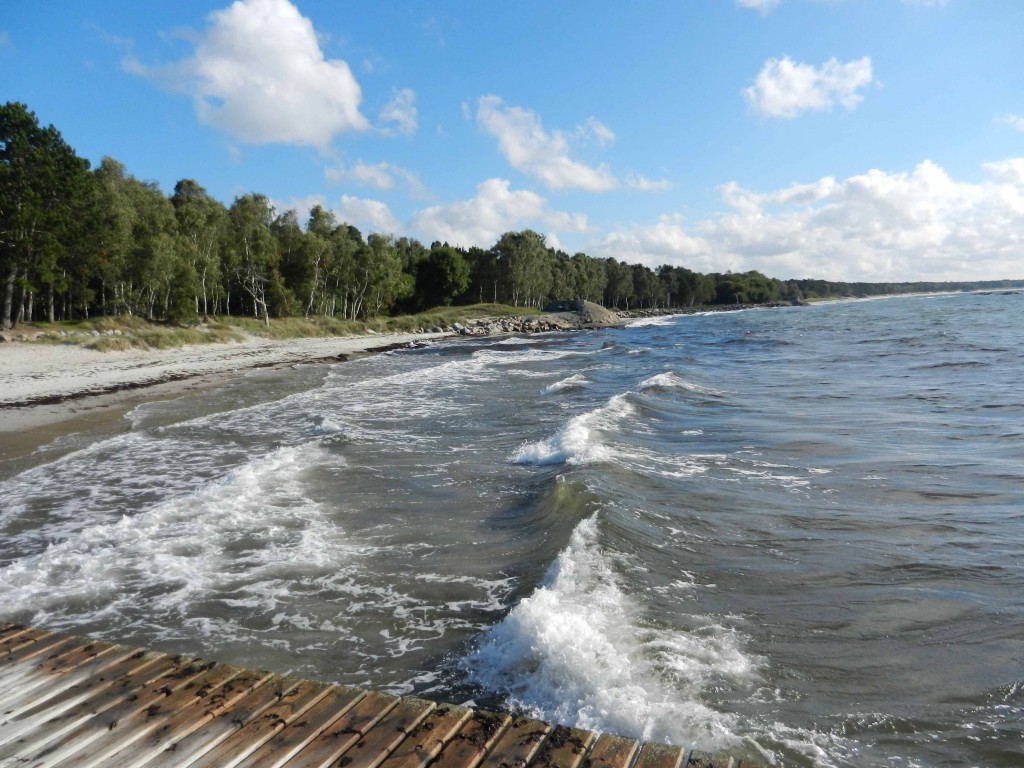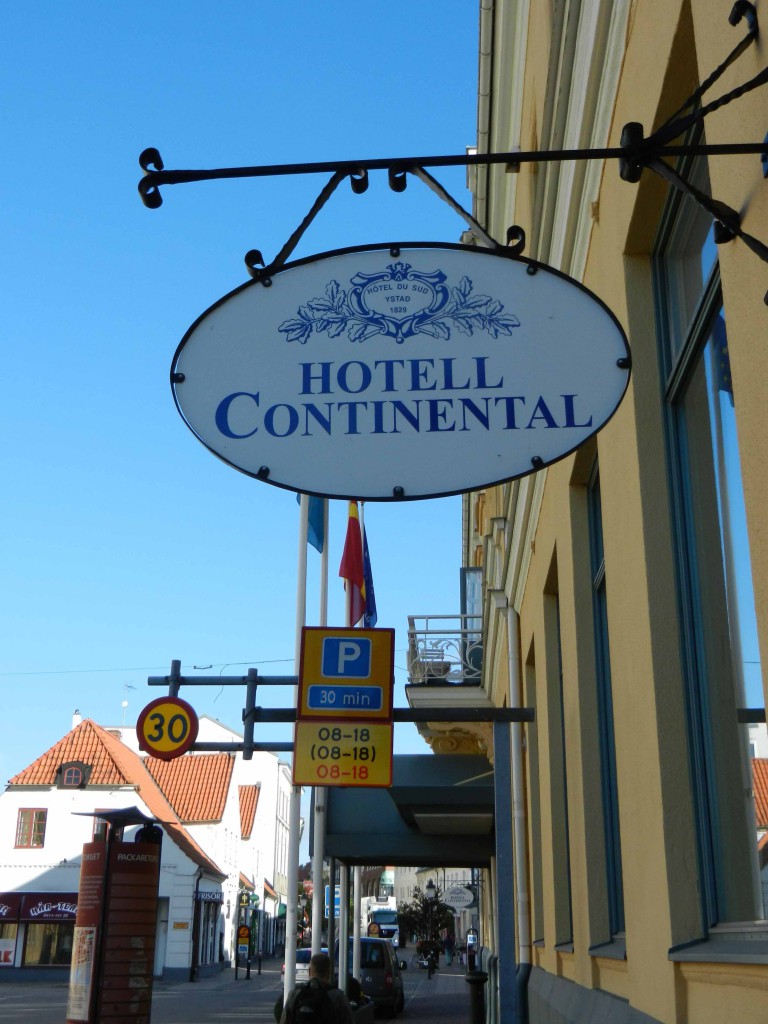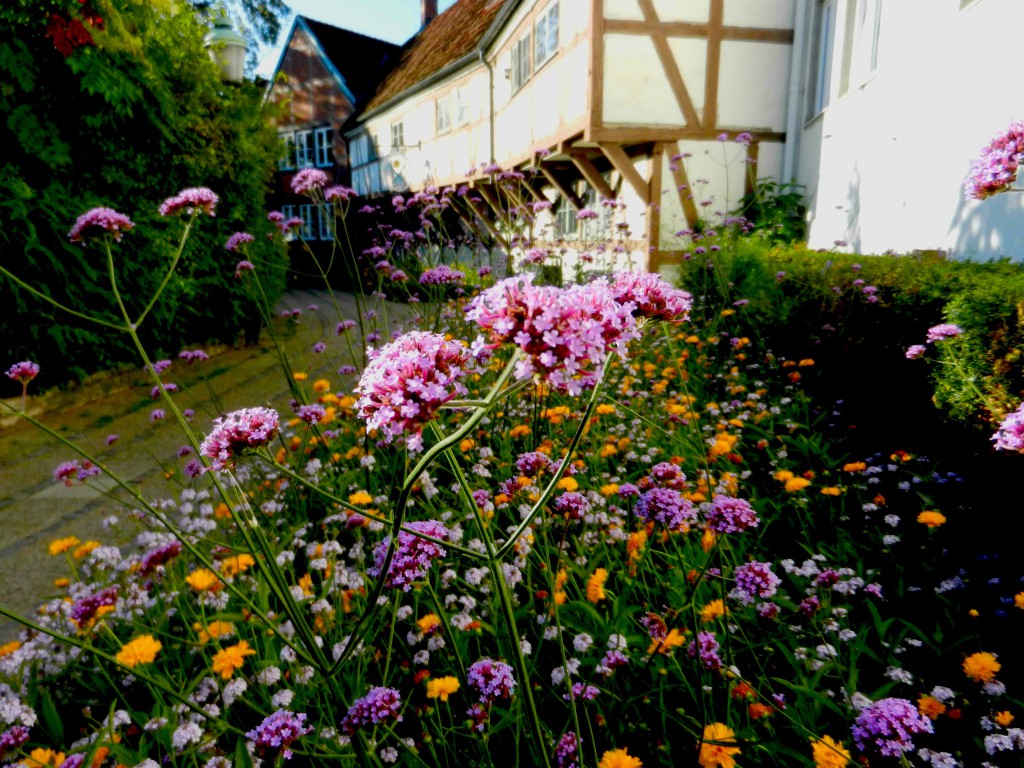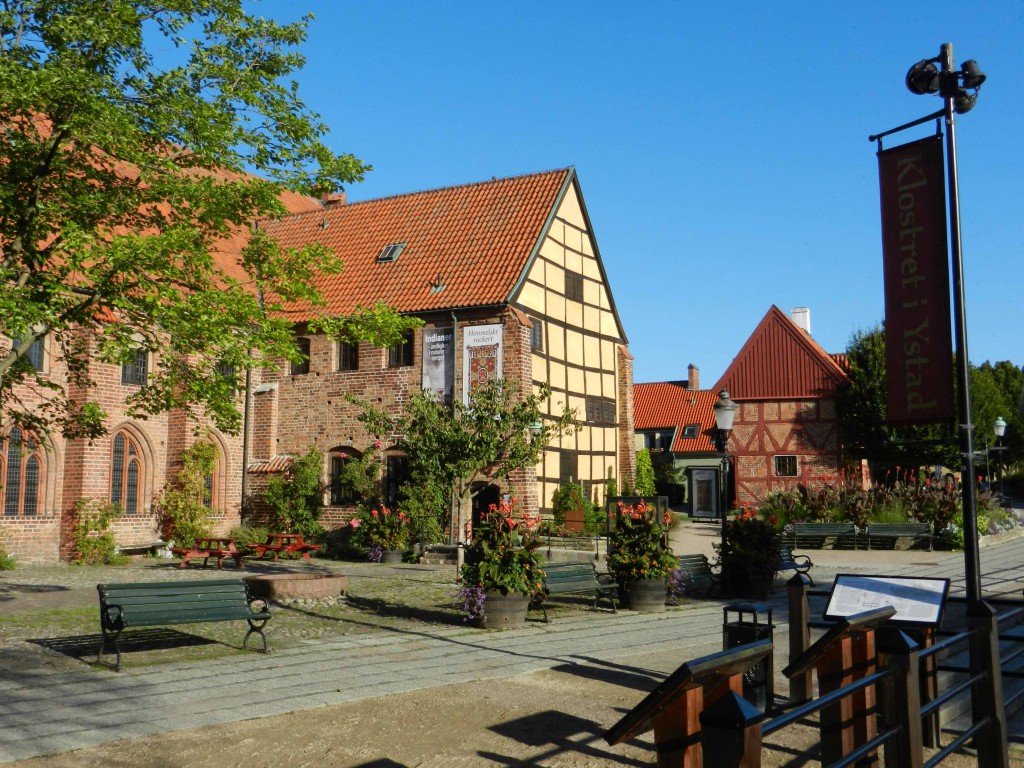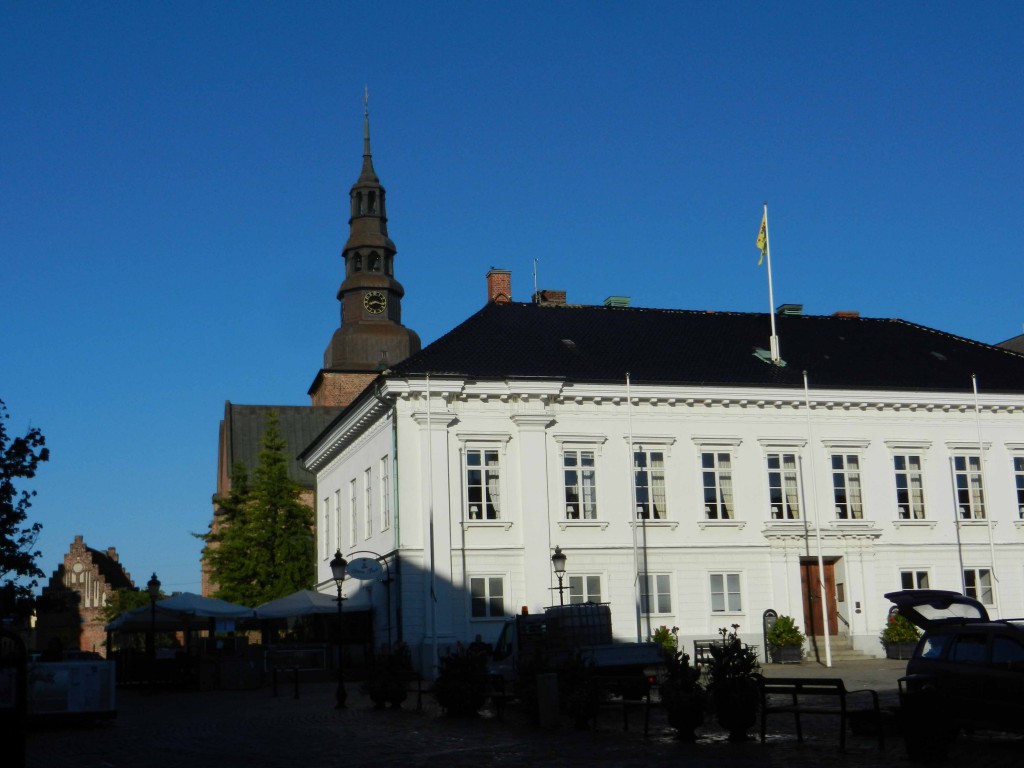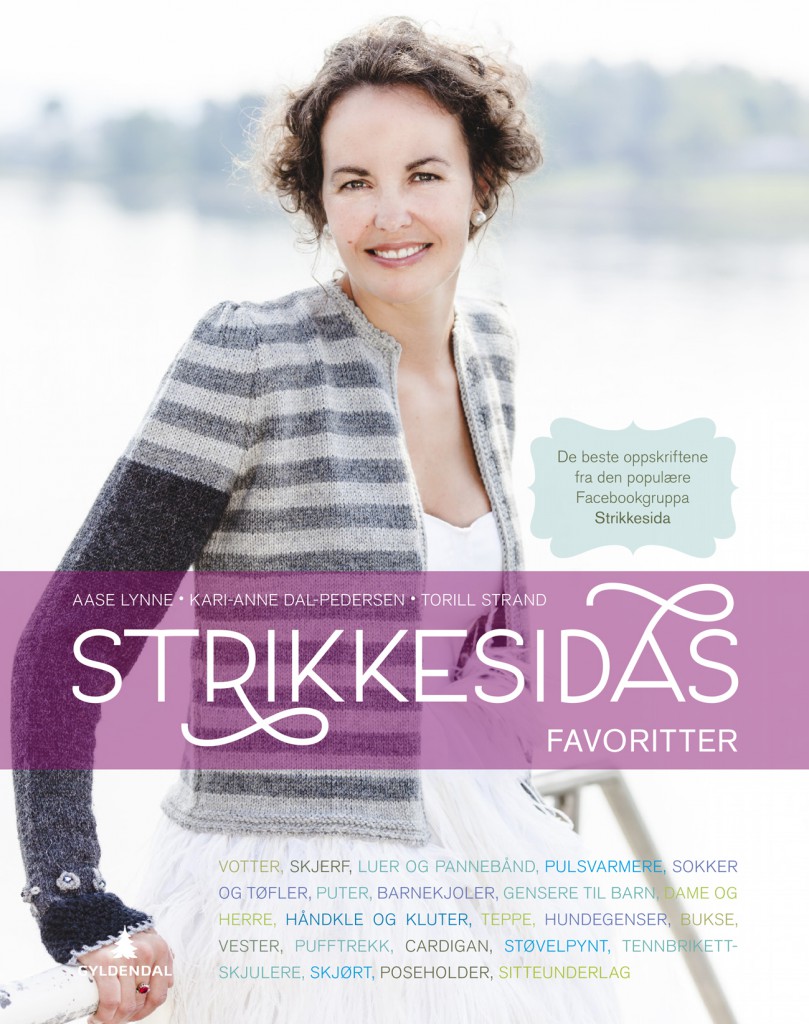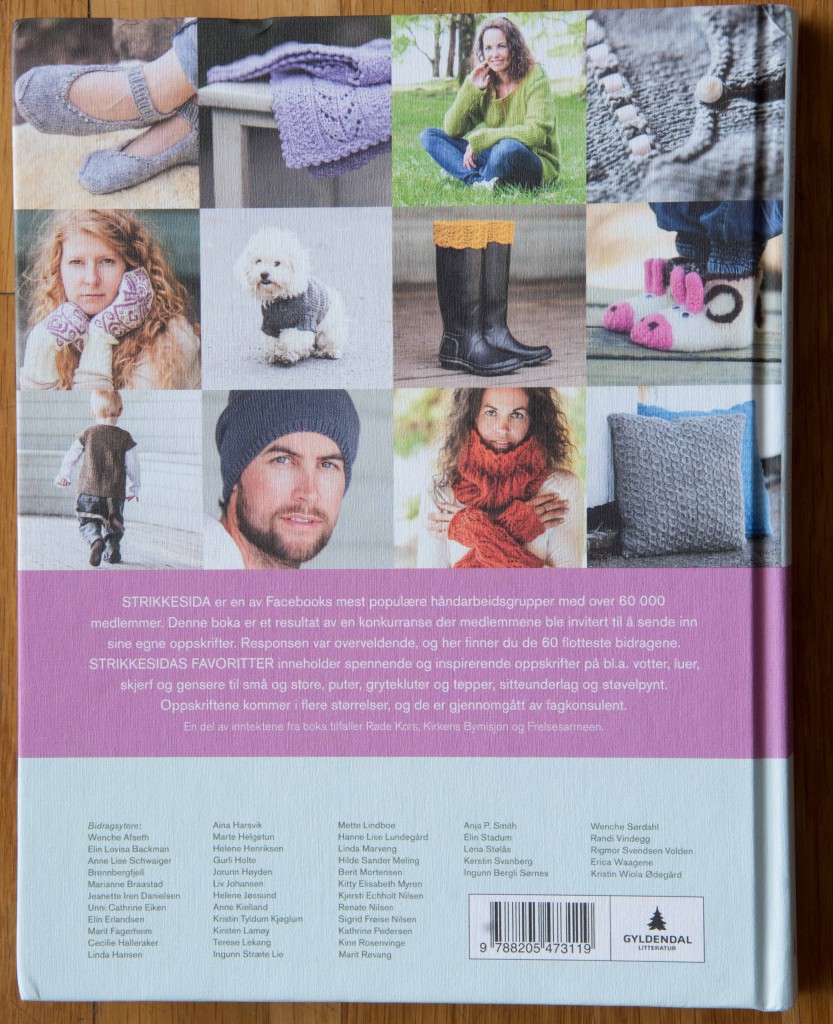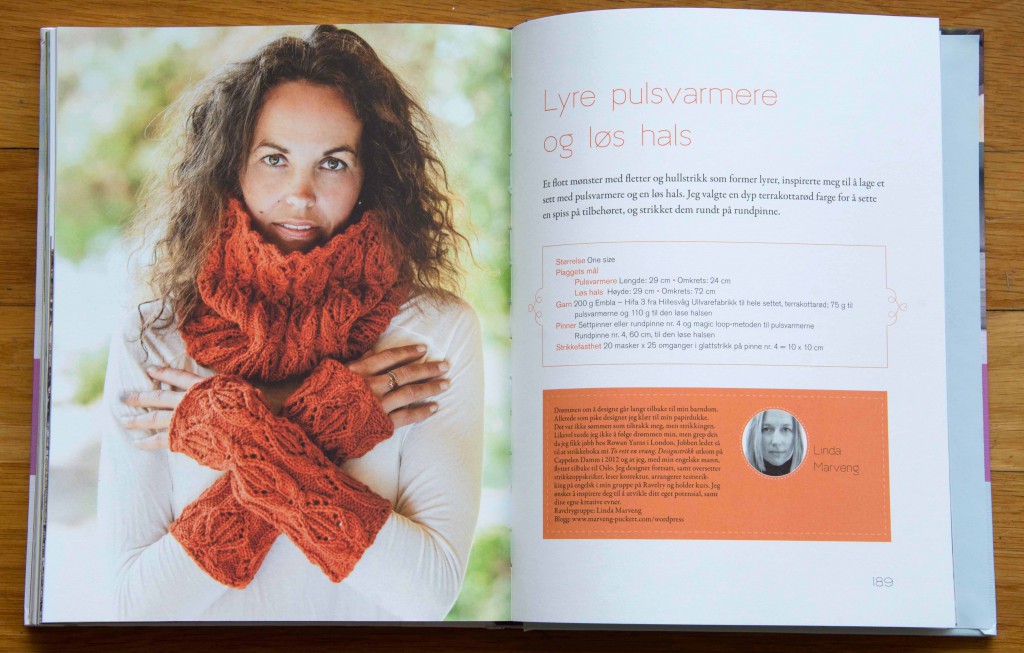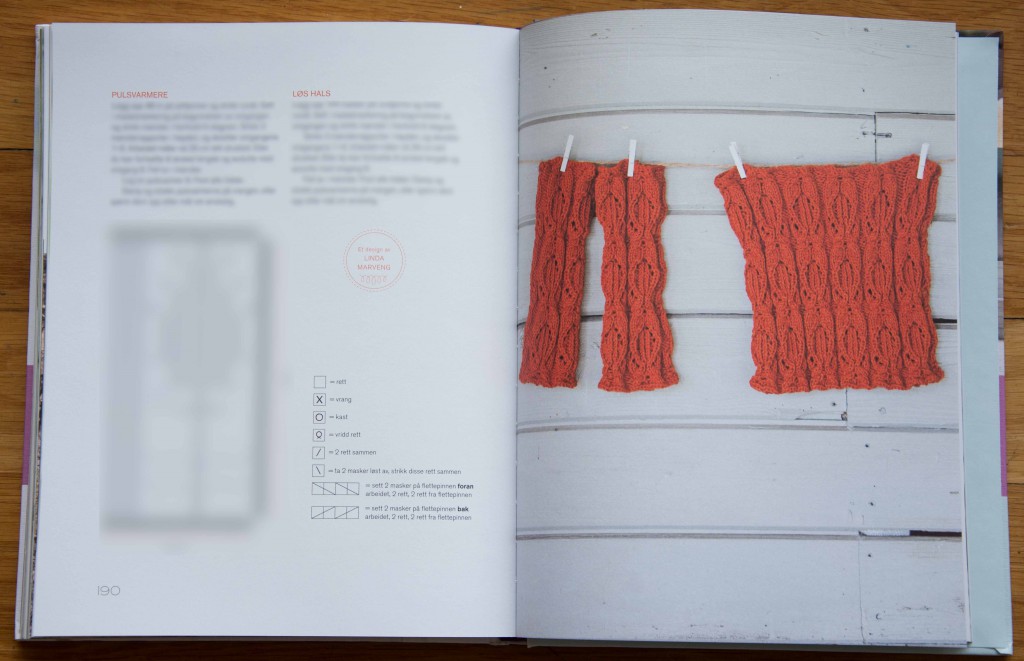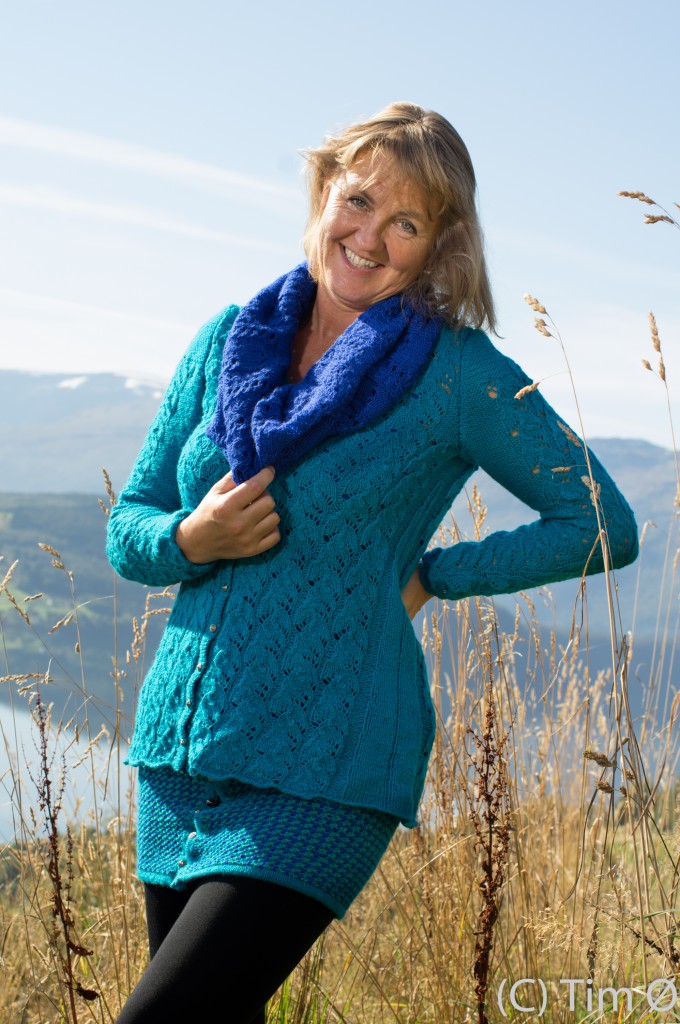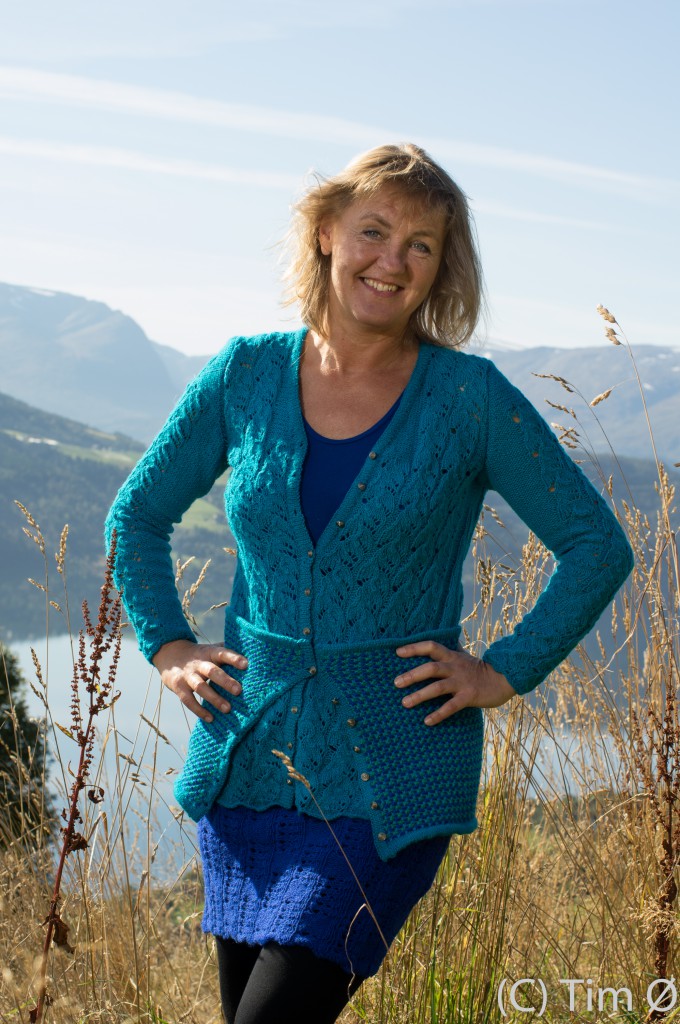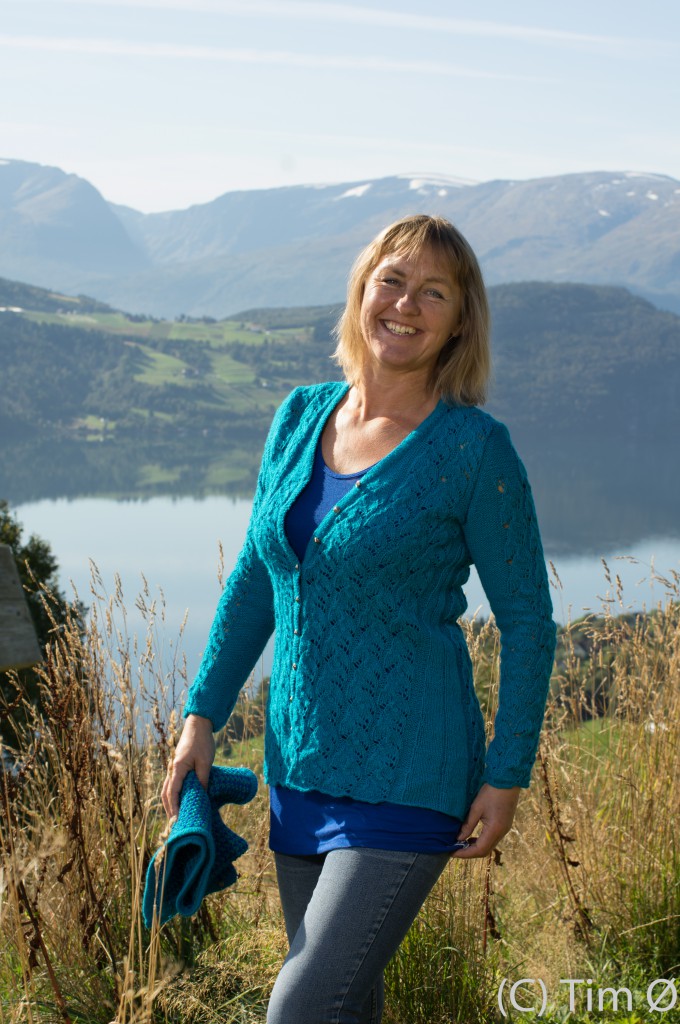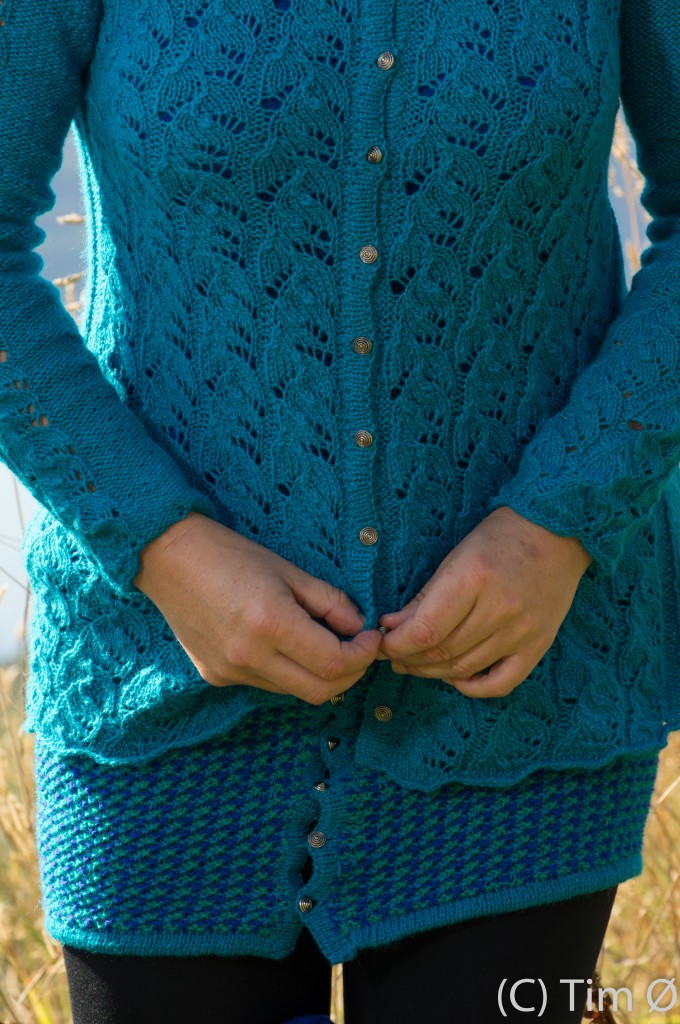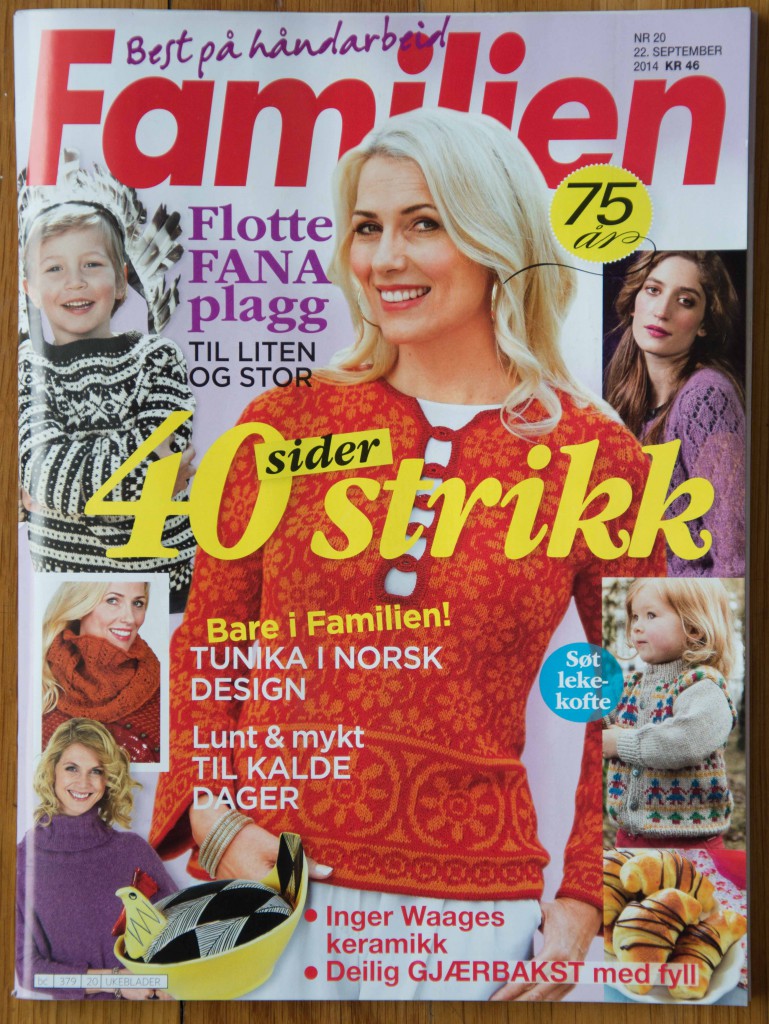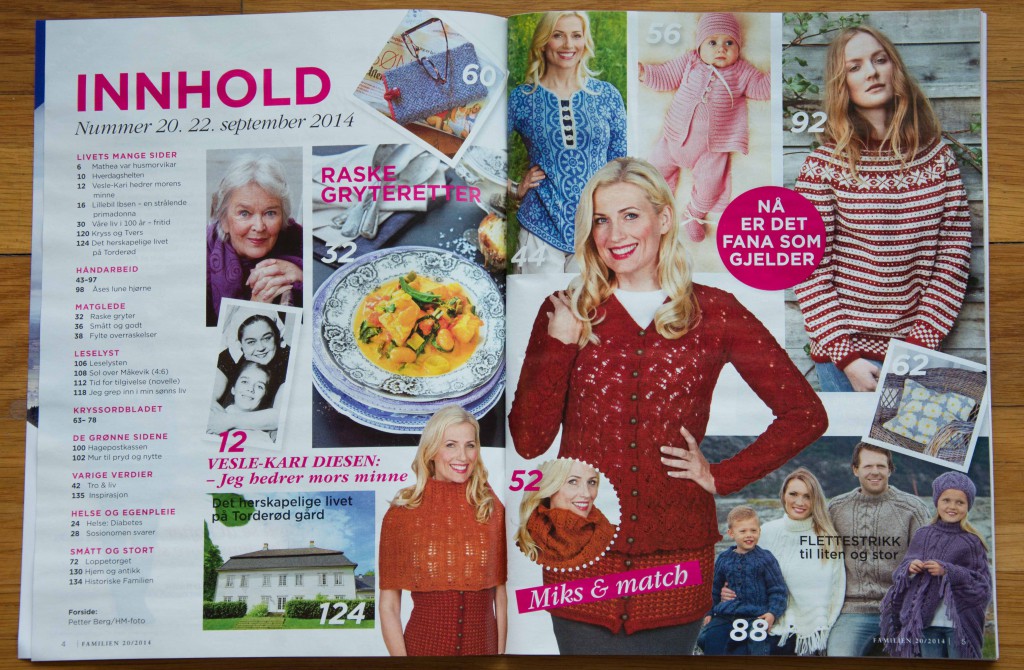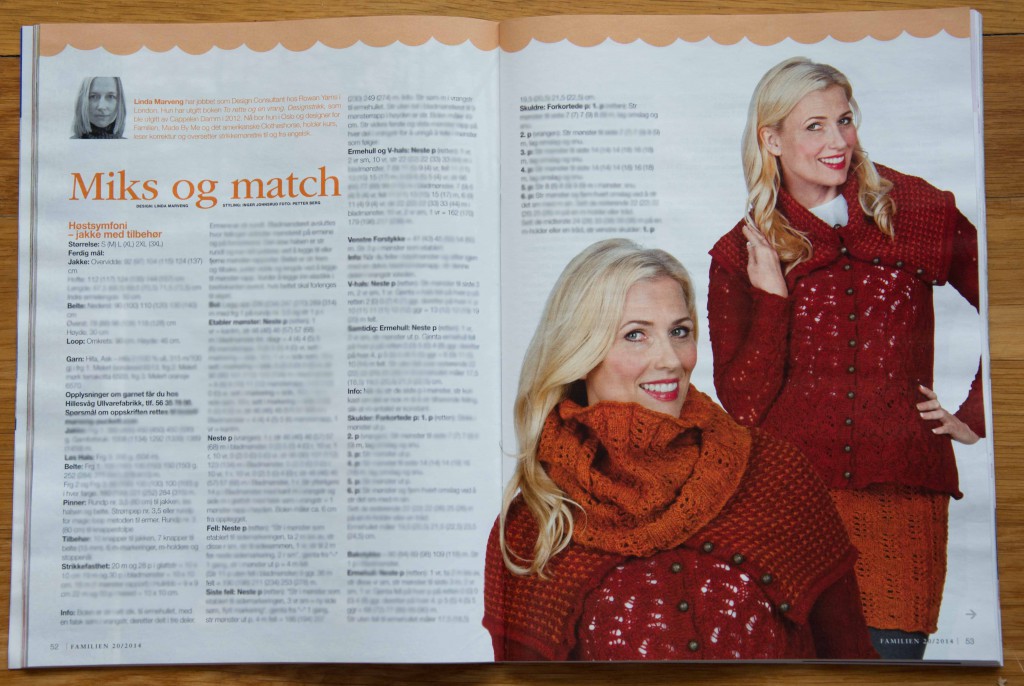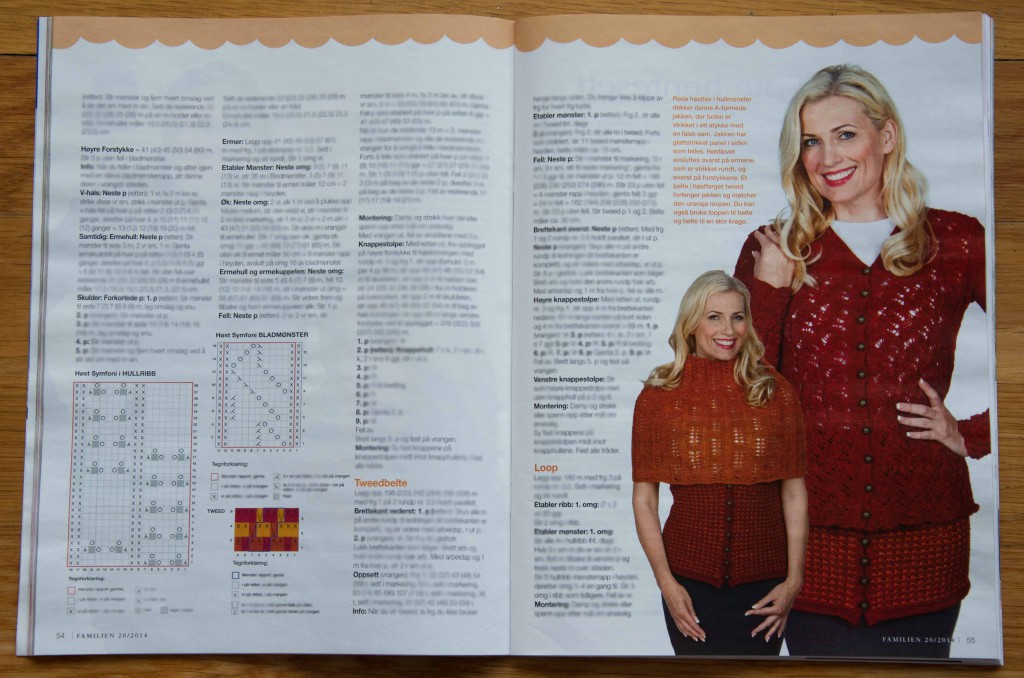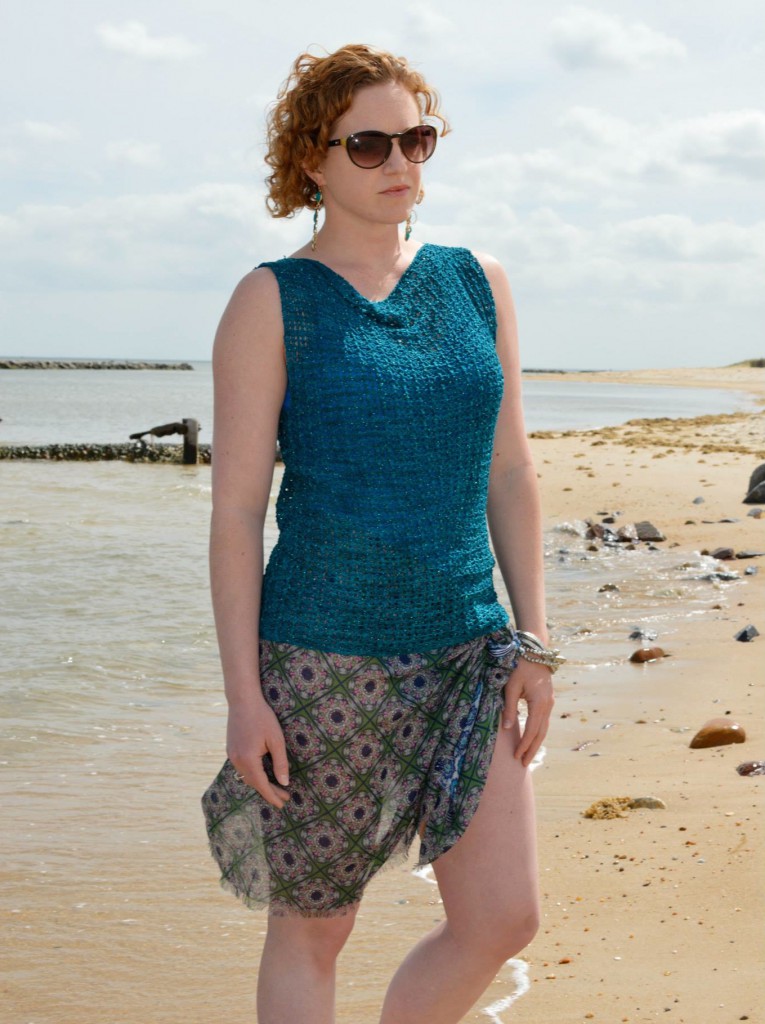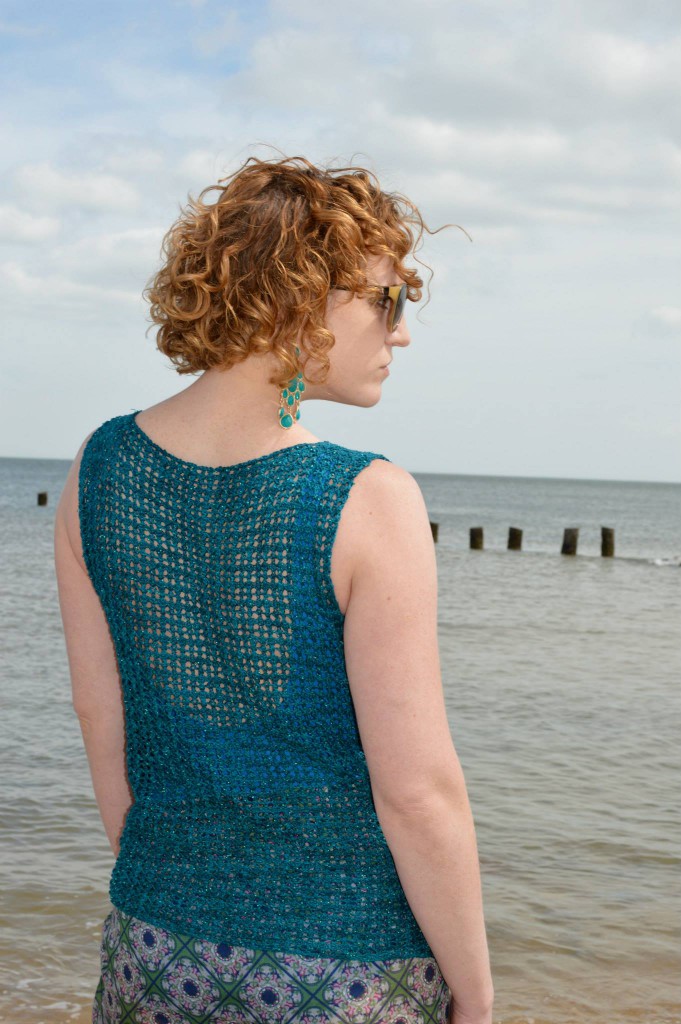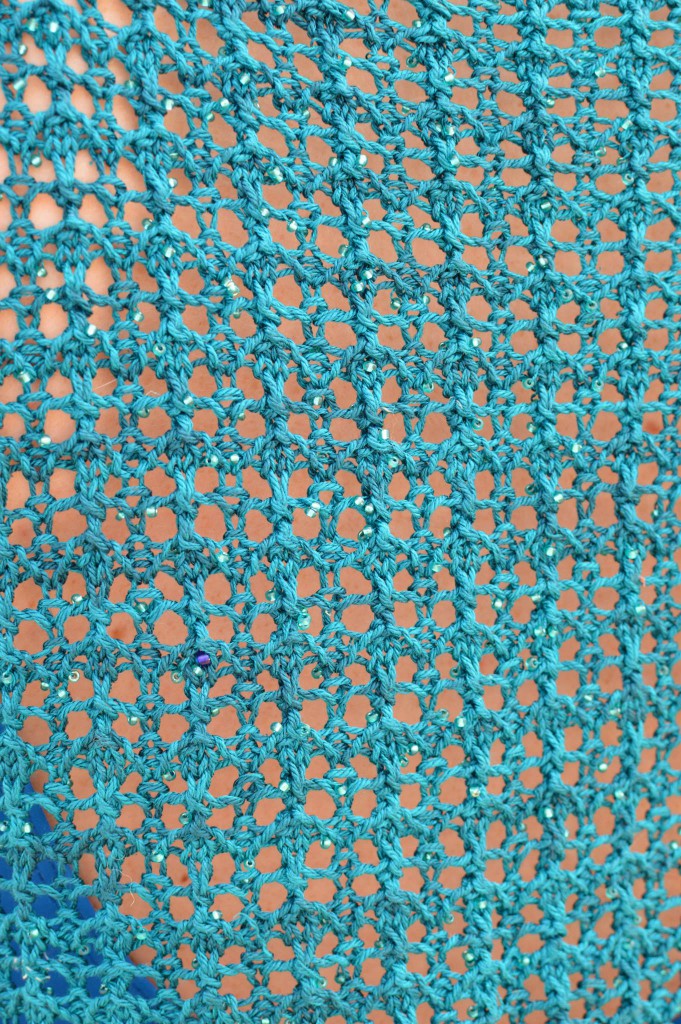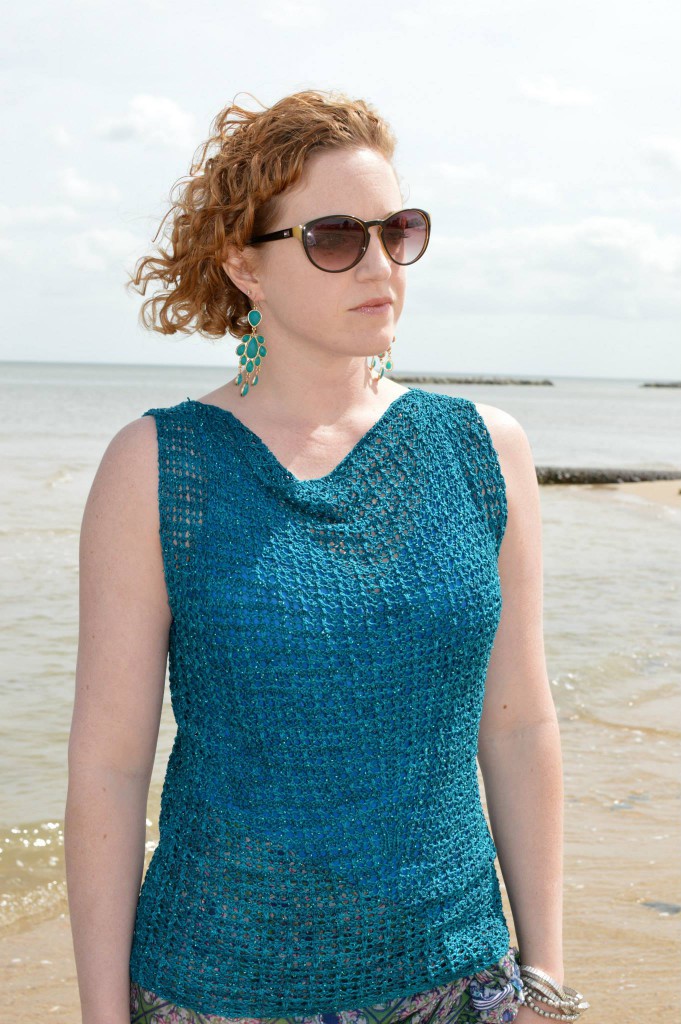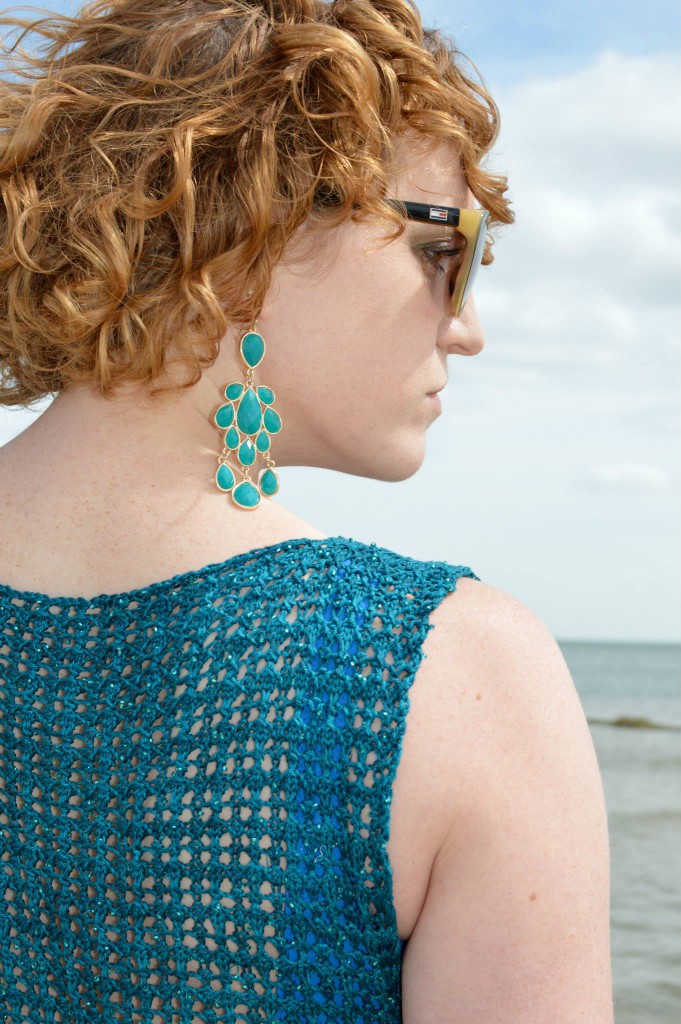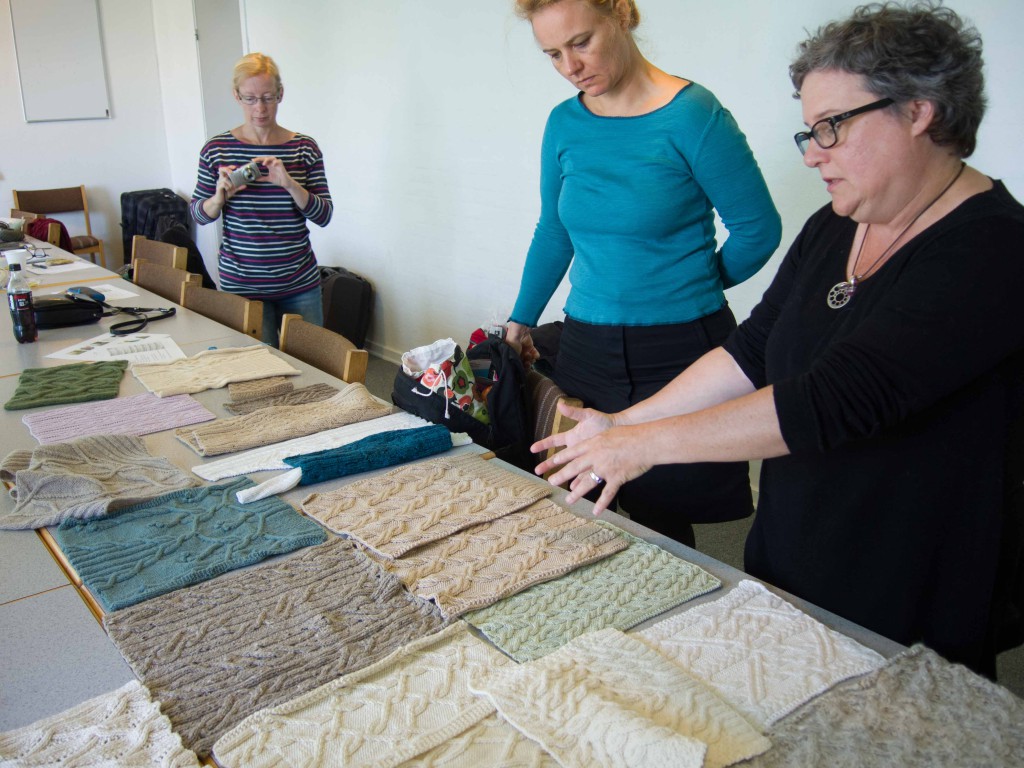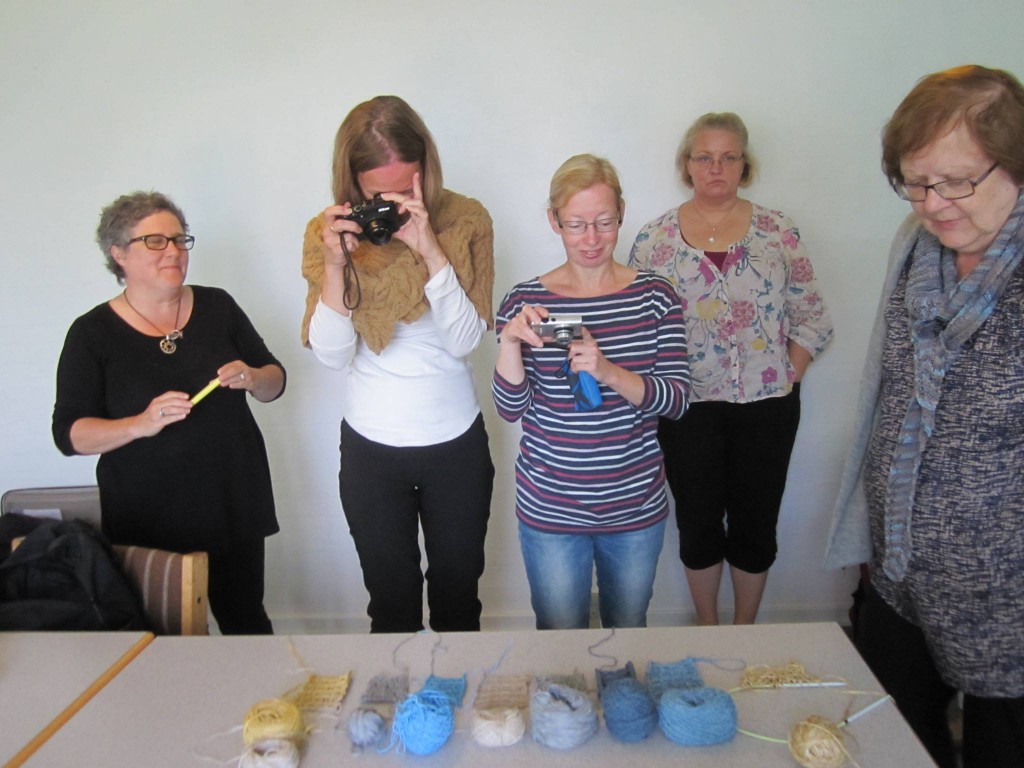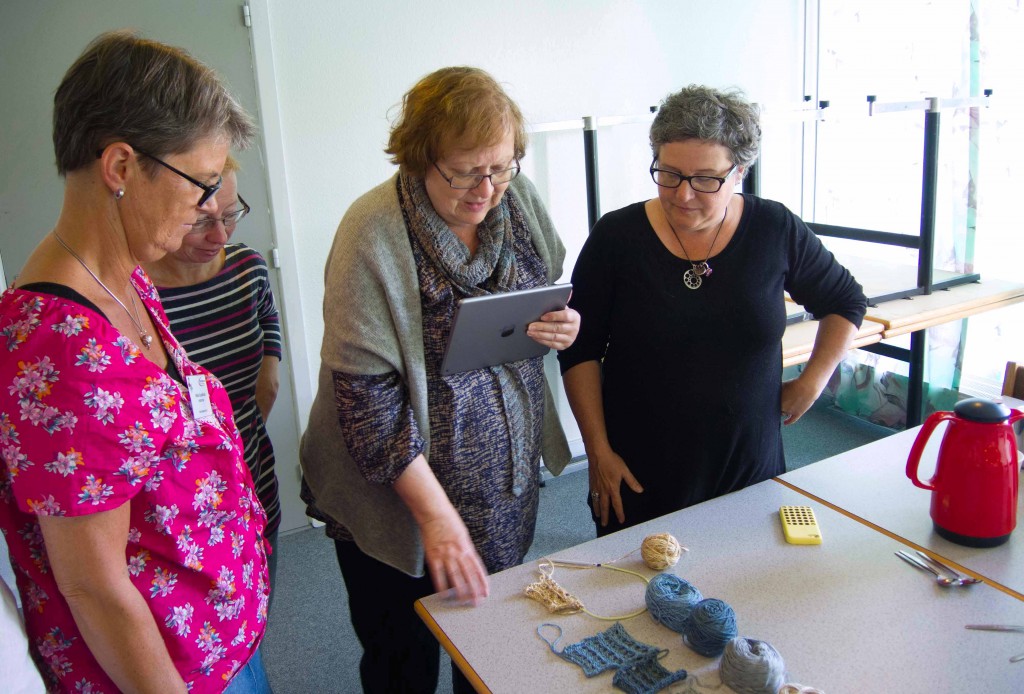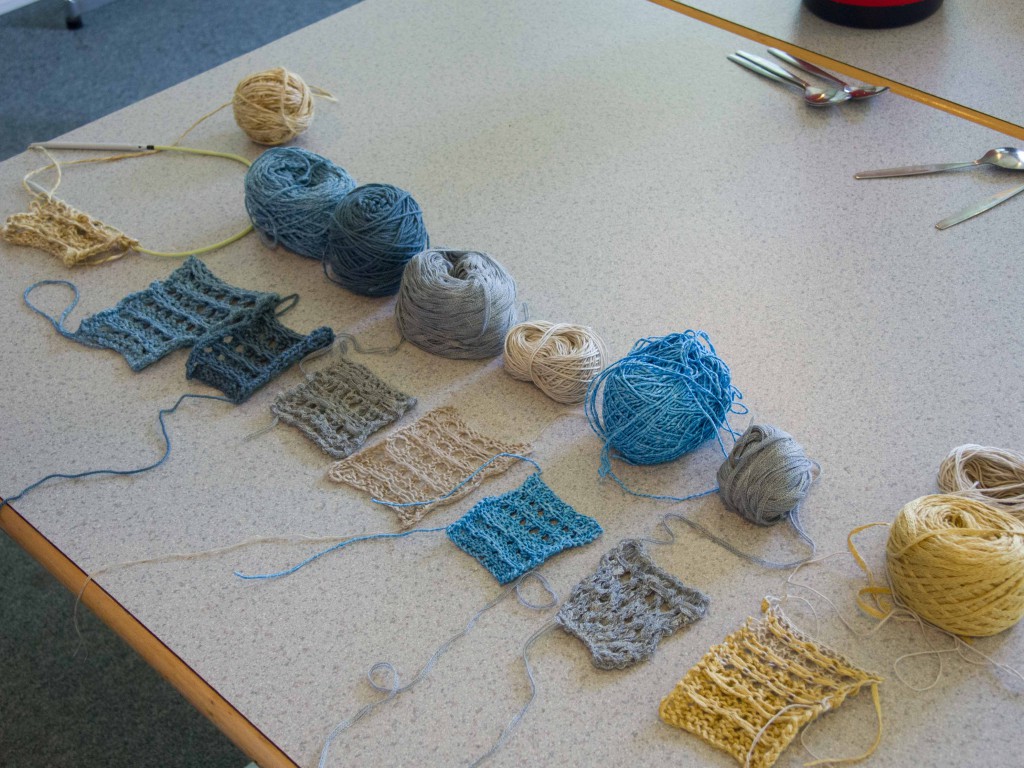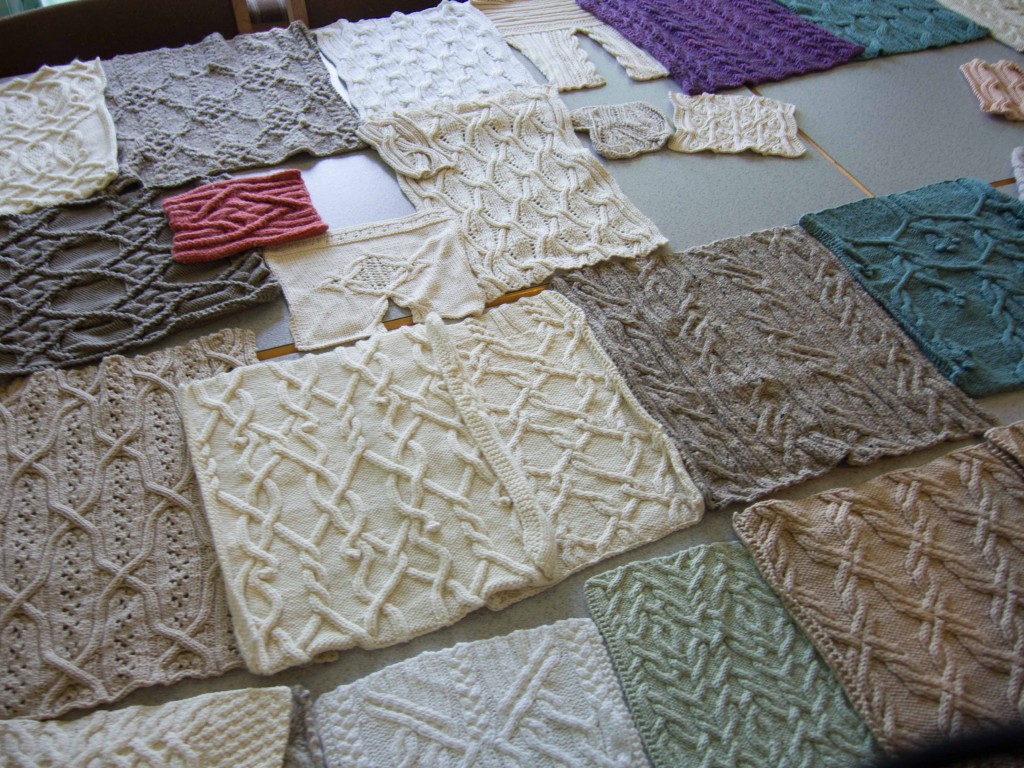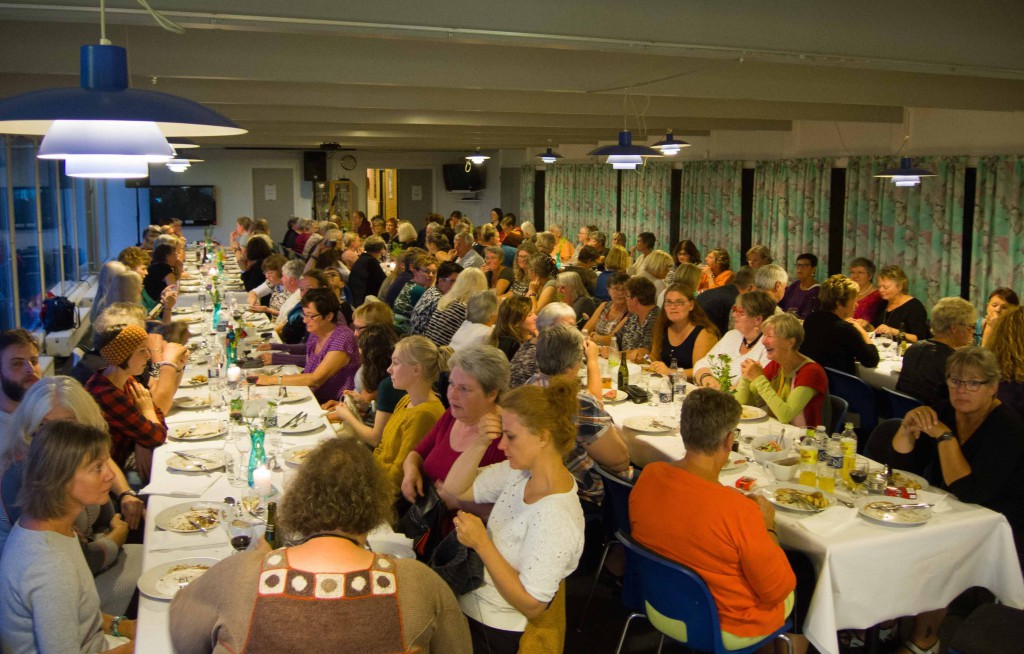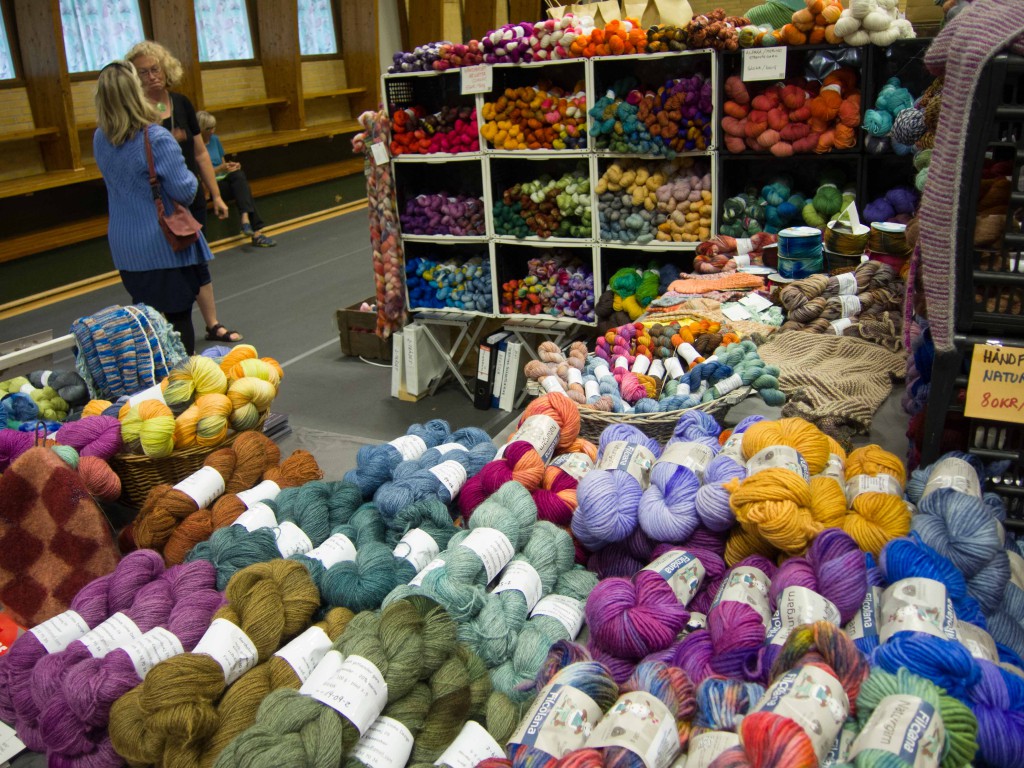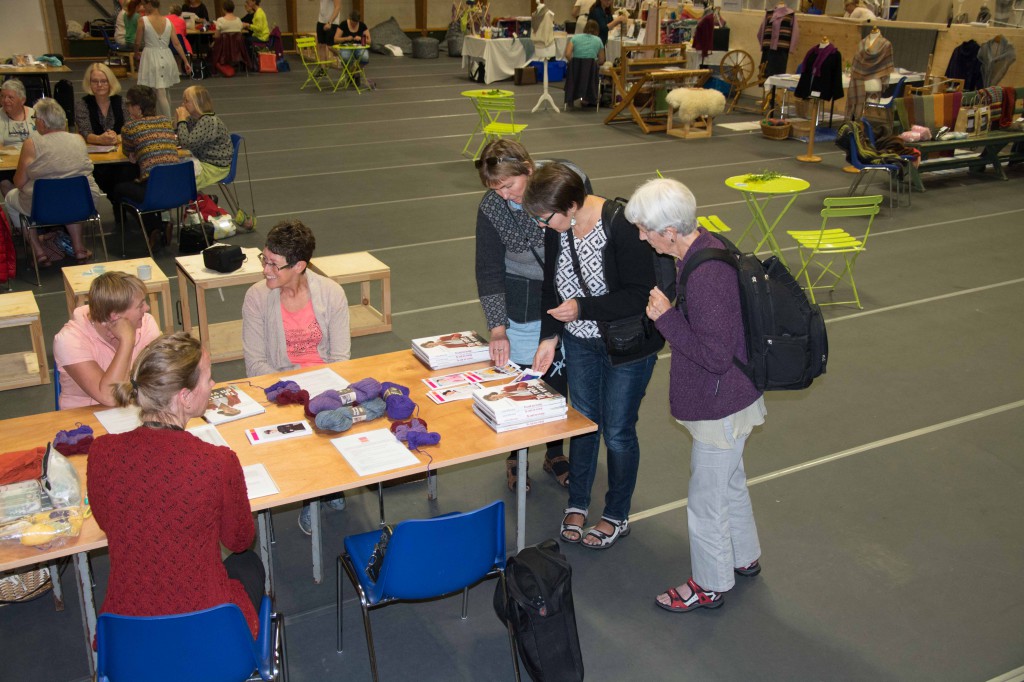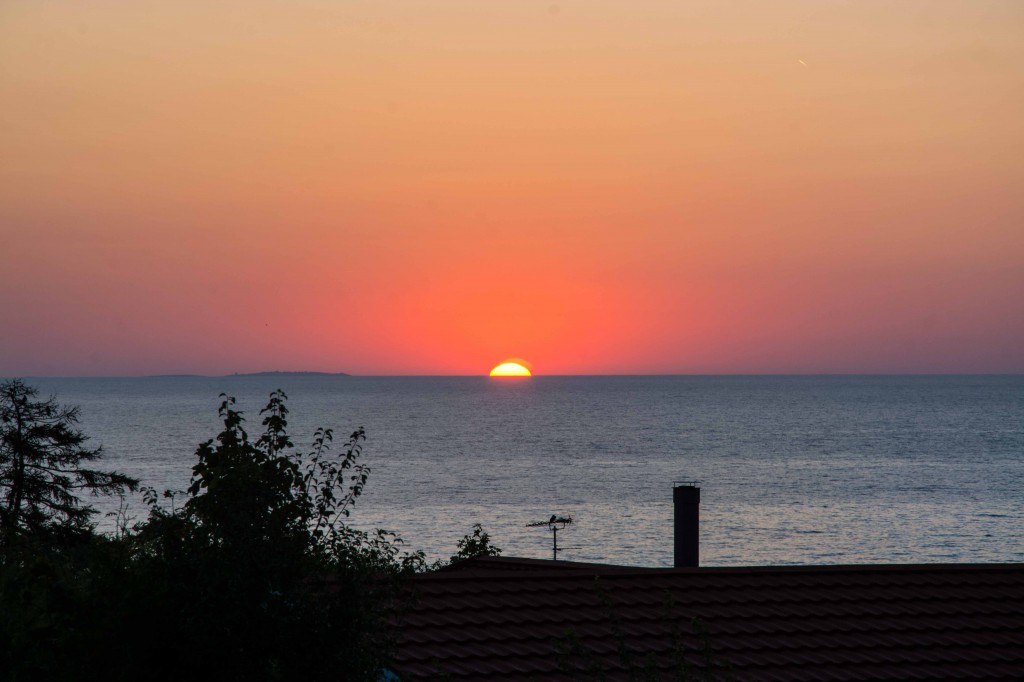 I was way too busy with Strik Bornholm to do any serious sightseeing, but I did have Sunday afternoon off, after participating in one of Norah Gaughan’s workshops. While I was holding my workshops, my husband had been sightseeing, and keeping me informed about what he thought was worth seeing. On top of that list was Hammershus Castle. On my list was Jons Kapel; that turned out not to be a seaside chapel, but a cliff (named after a hermit sent to Bornholm to bring Christianity to the islanders according to the legend) and it was quite a hike to get there too. The short drive from Rønne, one of the larger towns on the island where the ferry from Ystad arrives, to Allinge took less than an hour and provided us with a 180 degree view of the sea. The roads on Bornholm are perfect for cyclists, since they seem taken only by a few cars (tourists) and tractors. I had booked sea view from our holiday flat at Hotel Klintely and the morning sunrise was spectacular, see above. The island you can glimpse is Christiansø, the easternmost point of Denmark. Below is the day view from our terrace.
I was way too busy with Strik Bornholm to do any serious sightseeing, but I did have Sunday afternoon off, after participating in one of Norah Gaughan’s workshops. While I was holding my workshops, my husband had been sightseeing, and keeping me informed about what he thought was worth seeing. On top of that list was Hammershus Castle. On my list was Jons Kapel; that turned out not to be a seaside chapel, but a cliff (named after a hermit sent to Bornholm to bring Christianity to the islanders according to the legend) and it was quite a hike to get there too. The short drive from Rønne, one of the larger towns on the island where the ferry from Ystad arrives, to Allinge took less than an hour and provided us with a 180 degree view of the sea. The roads on Bornholm are perfect for cyclists, since they seem taken only by a few cars (tourists) and tractors. I had booked sea view from our holiday flat at Hotel Klintely and the morning sunrise was spectacular, see above. The island you can glimpse is Christiansø, the easternmost point of Denmark. Below is the day view from our terrace.
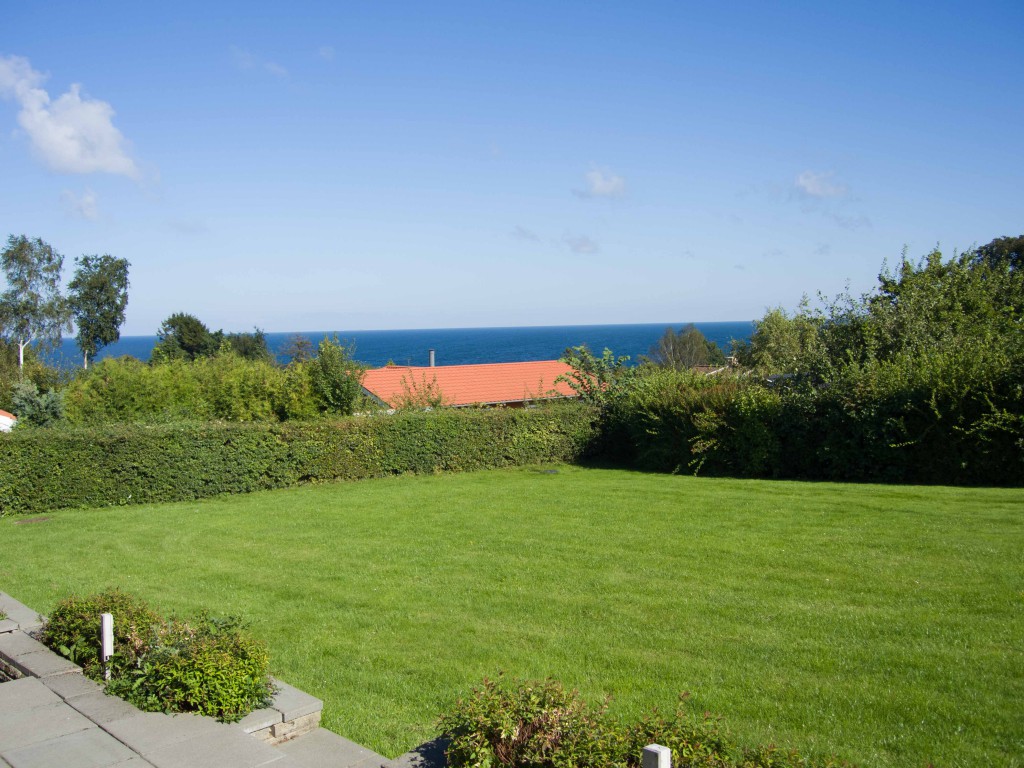 Allinge only has 1675 inhabitants, and was so idyllic with its old traditional building style. Several small harbors were scattered along the coastline, in between the long beach lines that provided kilometers of beach walks. The spectacular dome below, photographed by my husband who sneaked in during Norah Gaughan’s workshop, is located between Norlandshallen where the Exhibitors Hall was and Allinge Røgeri/Smokehouse on the beach.
Allinge only has 1675 inhabitants, and was so idyllic with its old traditional building style. Several small harbors were scattered along the coastline, in between the long beach lines that provided kilometers of beach walks. The spectacular dome below, photographed by my husband who sneaked in during Norah Gaughan’s workshop, is located between Norlandshallen where the Exhibitors Hall was and Allinge Røgeri/Smokehouse on the beach.
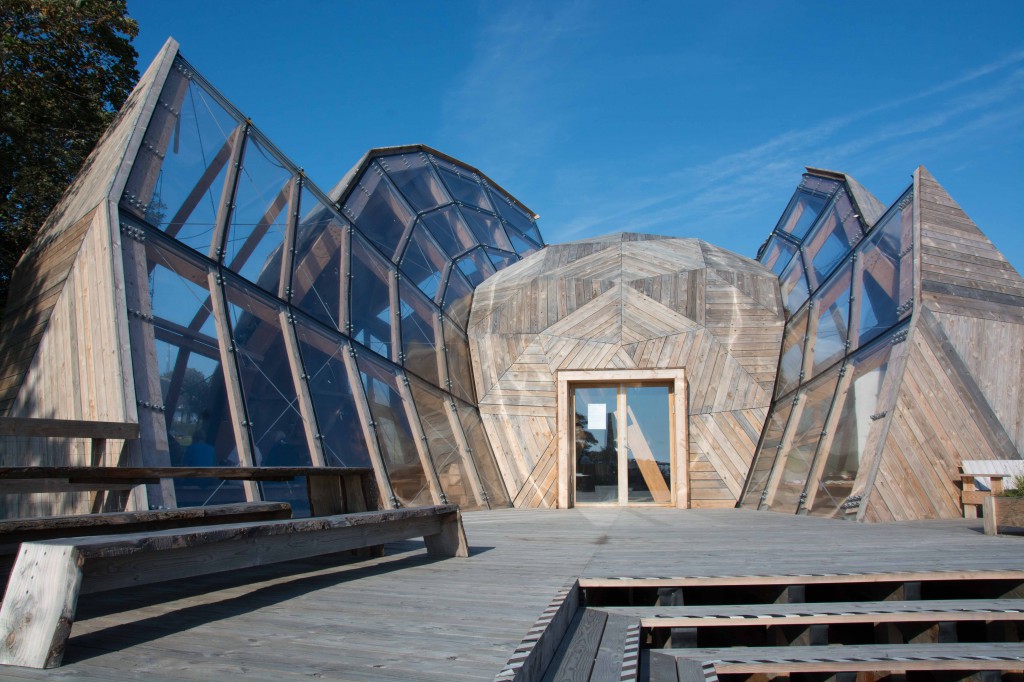 This dome is built by Boligselskabernes Landsforening/Denmark Public Housing and called the “Peoples Meeting Dome” according to the architects; Bureau Detours: “BL, Denmark Public Housing participated in this year’s Peoples Meeting on
Bornholm, in order to generate debate on the future of housing. According to BL a standard
exhibition tent would not do justice to a debate of such importance. Instead they wanted a
space that stuck out, inspired and invited inside.
In addition to creating the physical space for this debate, it was important for us that the
space also became an independent contribution.
We wish to stick out, but in the right way.
We have the ambition that architecture is to be as site-specific as possible, that architecture is
influenced by the local surroundings; the view, the landscape, the wind and the sun. And the
features it offers.
On the drawing board was a sketch model that has been a long time underway, but had been
missing the right circumstances, sentiments and audience. A model of a deconstructed
”Dome”, a construction iconized by the hippies in the 70s.” Continues with a lot more photos on Bureau Detours.
This dome is built by Boligselskabernes Landsforening/Denmark Public Housing and called the “Peoples Meeting Dome” according to the architects; Bureau Detours: “BL, Denmark Public Housing participated in this year’s Peoples Meeting on
Bornholm, in order to generate debate on the future of housing. According to BL a standard
exhibition tent would not do justice to a debate of such importance. Instead they wanted a
space that stuck out, inspired and invited inside.
In addition to creating the physical space for this debate, it was important for us that the
space also became an independent contribution.
We wish to stick out, but in the right way.
We have the ambition that architecture is to be as site-specific as possible, that architecture is
influenced by the local surroundings; the view, the landscape, the wind and the sun. And the
features it offers.
On the drawing board was a sketch model that has been a long time underway, but had been
missing the right circumstances, sentiments and audience. A model of a deconstructed
”Dome”, a construction iconized by the hippies in the 70s.” Continues with a lot more photos on Bureau Detours.
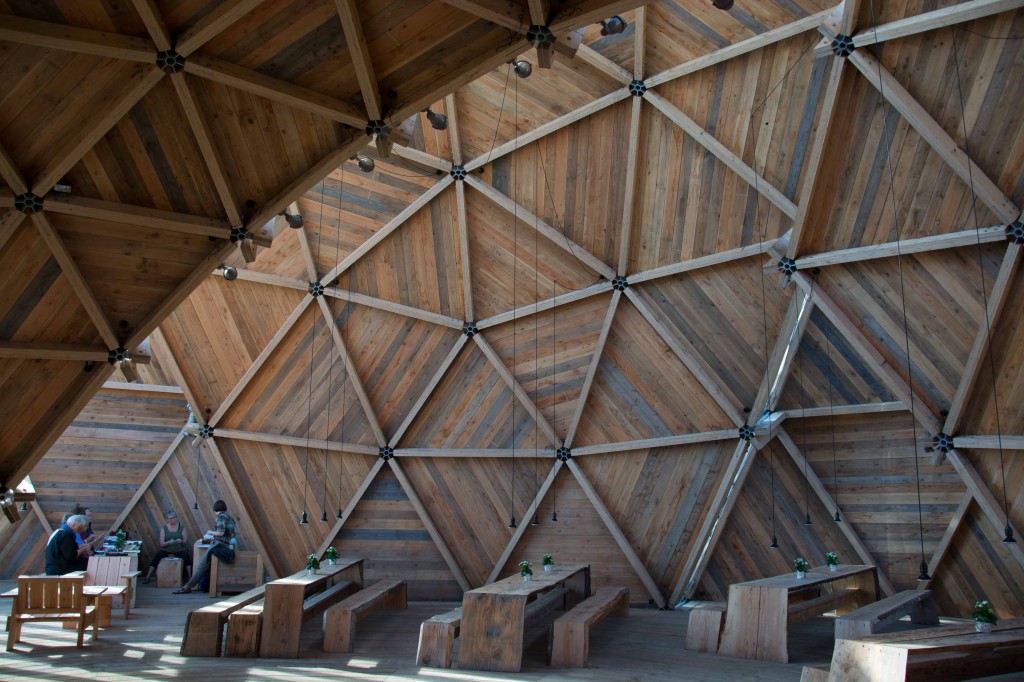 Inside was a workshop held by Norah Gaughan in progress. Despite its fantastic interior, it did not contain the most comfortable benches to sit on during a 6 hours workshop, hence a number of knitters had moved outside when time came for individual work.
Inside was a workshop held by Norah Gaughan in progress. Despite its fantastic interior, it did not contain the most comfortable benches to sit on during a 6 hours workshop, hence a number of knitters had moved outside when time came for individual work.
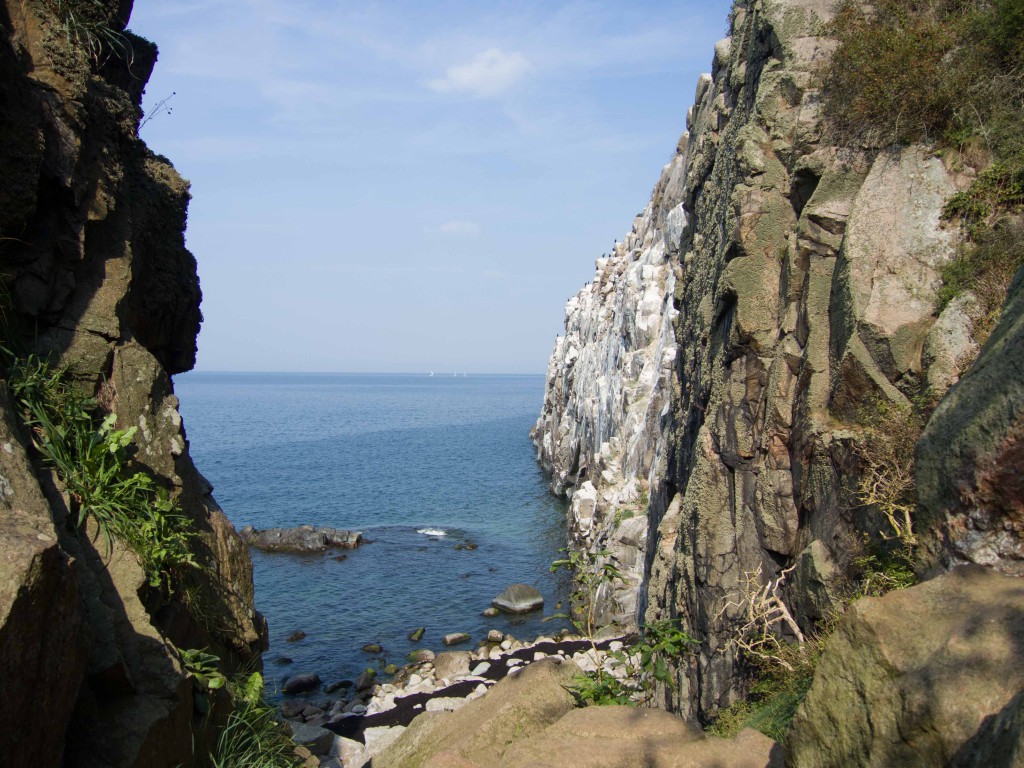 “The rocky cliffs of Jons Kapel, which give a panoramic view of the west coast of the island, are reached from the car park on Jons Kapelvej by descending a steep path beside a little stream called Askebækken. Jons Kapel can be seen from the beach, north of the point where the path reaches the coast. The cliffs consist of Vang granite, named after the fishing village of Vang, just to the north. The cliff has several caves. Jon’s Cave is high above the sea. North of the cave, there is an almost vertical rockface known as Hvidkleven (White Cliff). The caves to the south are known as Jons Sovekammer (Jon’s Bedroom), Jons Sakristi, Jons Spisestue (Jon’s Dining Room) and Jons Madkælder (Jon’s Food Cellar)”. More on Wikipedia. It provided us with the exercise for the day.
“The rocky cliffs of Jons Kapel, which give a panoramic view of the west coast of the island, are reached from the car park on Jons Kapelvej by descending a steep path beside a little stream called Askebækken. Jons Kapel can be seen from the beach, north of the point where the path reaches the coast. The cliffs consist of Vang granite, named after the fishing village of Vang, just to the north. The cliff has several caves. Jon’s Cave is high above the sea. North of the cave, there is an almost vertical rockface known as Hvidkleven (White Cliff). The caves to the south are known as Jons Sovekammer (Jon’s Bedroom), Jons Sakristi, Jons Spisestue (Jon’s Dining Room) and Jons Madkælder (Jon’s Food Cellar)”. More on Wikipedia. It provided us with the exercise for the day.
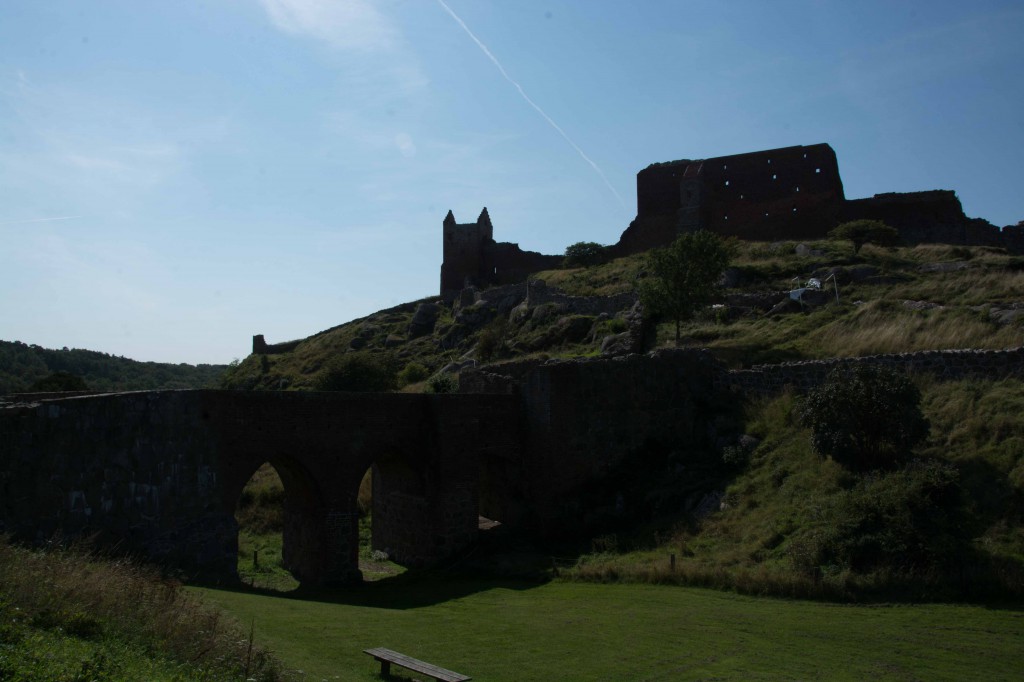 A short drive away is Hammershus “the largest castle ruin in Northern Europe and the most popular attraction on Bornholm. The oldest part of the fortress was probably built in the early 12th century to consolidate control of the island by the Archbishop of Lund (which was then part of Denmark), which he had acquired through a treaty with King Svend III Grathe of Denmark. For the next 500 years Hammershus was the stronghold of the island’s various rulers. Hammershus was rebuilt and extended on several occasions.” See more on: Bornholm Info. You could easily imagine how glorious the Castle must have looked in its heyday, and it was hard not think of Shakespeare’s Hamlet while walking around. See the setting above, photographed by my husband.
A short drive away is Hammershus “the largest castle ruin in Northern Europe and the most popular attraction on Bornholm. The oldest part of the fortress was probably built in the early 12th century to consolidate control of the island by the Archbishop of Lund (which was then part of Denmark), which he had acquired through a treaty with King Svend III Grathe of Denmark. For the next 500 years Hammershus was the stronghold of the island’s various rulers. Hammershus was rebuilt and extended on several occasions.” See more on: Bornholm Info. You could easily imagine how glorious the Castle must have looked in its heyday, and it was hard not think of Shakespeare’s Hamlet while walking around. See the setting above, photographed by my husband.
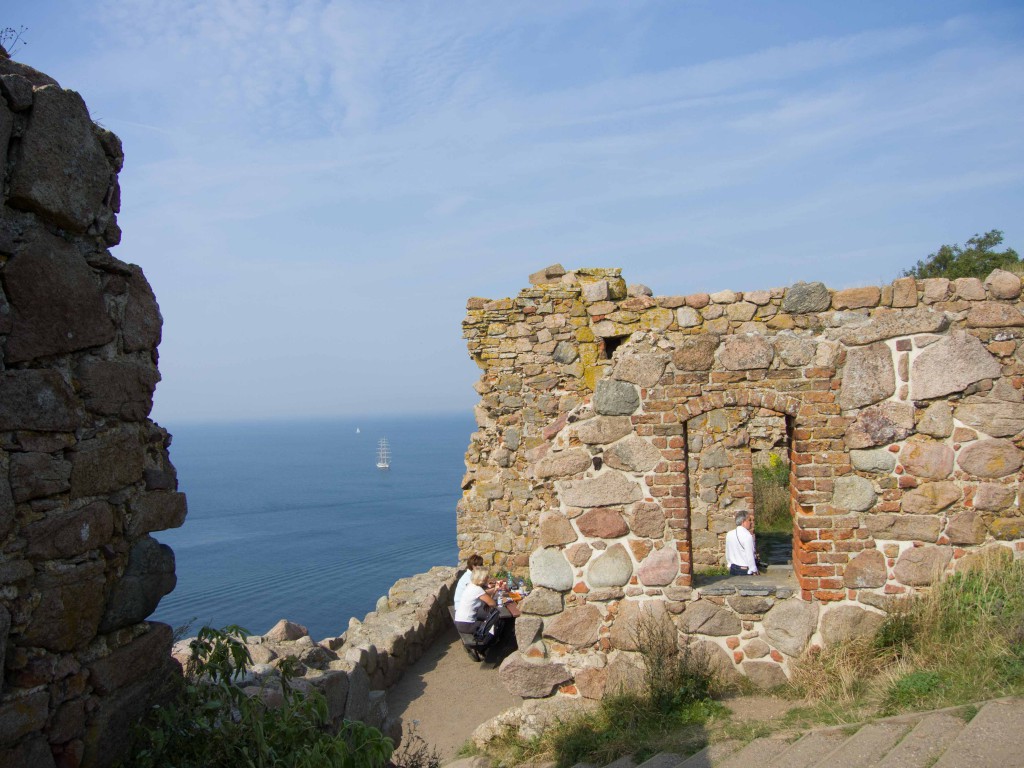 The sea view was spectacular. No wonder that a number of people had decided to have their picnic at the castle. We were lucky enough to spot the café shop and some cake. Above I framed my husband with my camera lens.
The sea view was spectacular. No wonder that a number of people had decided to have their picnic at the castle. We were lucky enough to spot the café shop and some cake. Above I framed my husband with my camera lens.
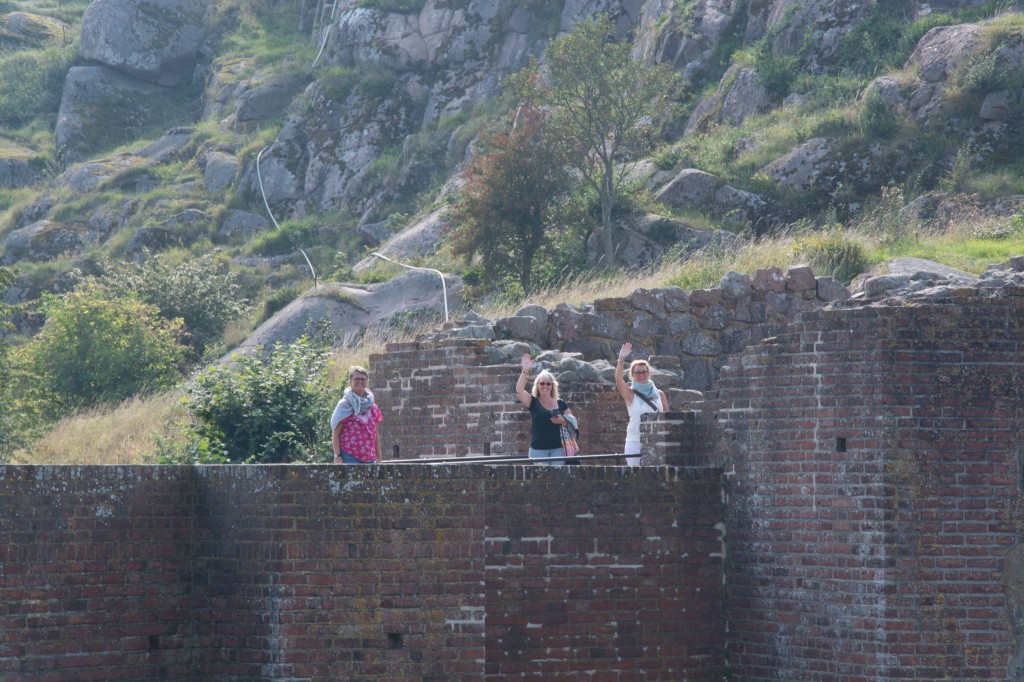 We bumped into designer Maria Gustafson, designer Kerstin Lindh, aka Alalindh and Christina at the Castle. Until next time we said, and caught them on camera waving goodbye.
We bumped into designer Maria Gustafson, designer Kerstin Lindh, aka Alalindh and Christina at the Castle. Until next time we said, and caught them on camera waving goodbye.
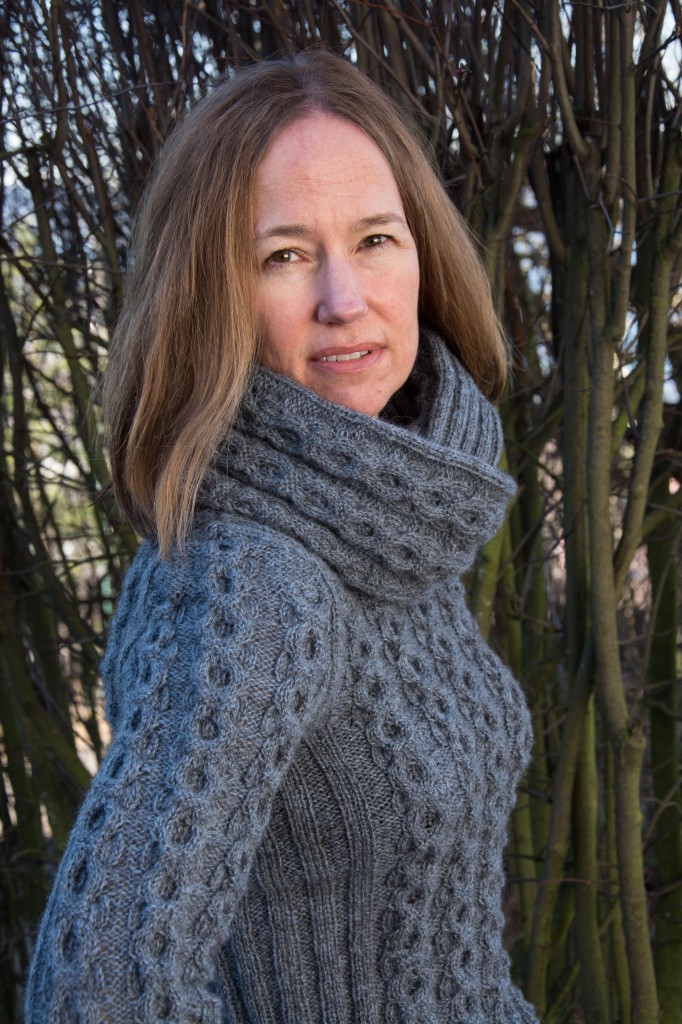 This sweater is not new, since it was published in Norwegian in issue 2/2014 of Made By Me, but I would like to share my ideas behind it, and the photos my husband took of me wearing Cable Round Sweater. Here is my introduction to it: The light denim blue colour in the stunning Norsk Pelsull/Norwegian Pelt Yarn from Hifa, captivated me. I chose a round cable with a band on. By framing the cables with a rib, the sweater became figure hugging and a perfect accompany to your favourite jeans or trouser. It ends with a square narrow neckband so that you can choose if you want to add the matching cowl. This is my idea of a simple pattern; The Sweater, both the sleeves and the body are worked in the round to the armhole and then worked back and forth in rows, using 3.5 mm/US 4 needles. The cowl is worked in the round as a long tube, and then the ends are joined together with mattress stitches but you could easily use a temporary cast-on method and graft the ends together. The English pattern will be test knitted in my Ravelry group later this month, and I know to my delight that a few of you are waiting eagerly for it.
This sweater is not new, since it was published in Norwegian in issue 2/2014 of Made By Me, but I would like to share my ideas behind it, and the photos my husband took of me wearing Cable Round Sweater. Here is my introduction to it: The light denim blue colour in the stunning Norsk Pelsull/Norwegian Pelt Yarn from Hifa, captivated me. I chose a round cable with a band on. By framing the cables with a rib, the sweater became figure hugging and a perfect accompany to your favourite jeans or trouser. It ends with a square narrow neckband so that you can choose if you want to add the matching cowl. This is my idea of a simple pattern; The Sweater, both the sleeves and the body are worked in the round to the armhole and then worked back and forth in rows, using 3.5 mm/US 4 needles. The cowl is worked in the round as a long tube, and then the ends are joined together with mattress stitches but you could easily use a temporary cast-on method and graft the ends together. The English pattern will be test knitted in my Ravelry group later this month, and I know to my delight that a few of you are waiting eagerly for it.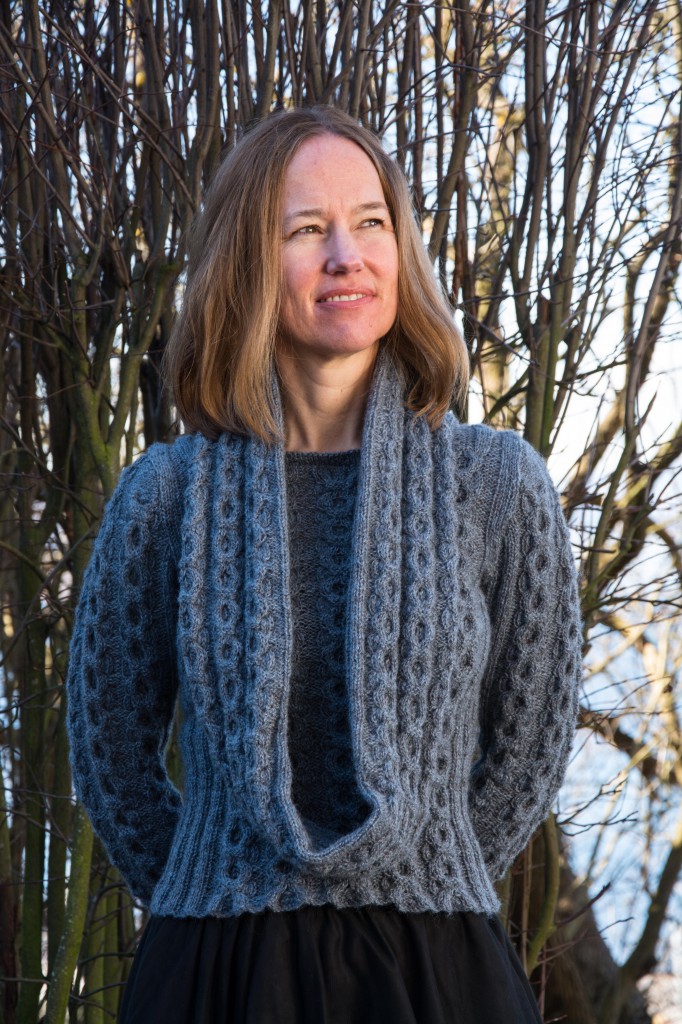 Here is another photo this time with the cowl hanging loose making the sweater looking more dressy. The cowl is half cable half rib so that you can see both stitch patterns. There is no shaping on the body of the sweater since the ribbing holds it in and make it appear shaped.
Here is another photo this time with the cowl hanging loose making the sweater looking more dressy. The cowl is half cable half rib so that you can see both stitch patterns. There is no shaping on the body of the sweater since the ribbing holds it in and make it appear shaped.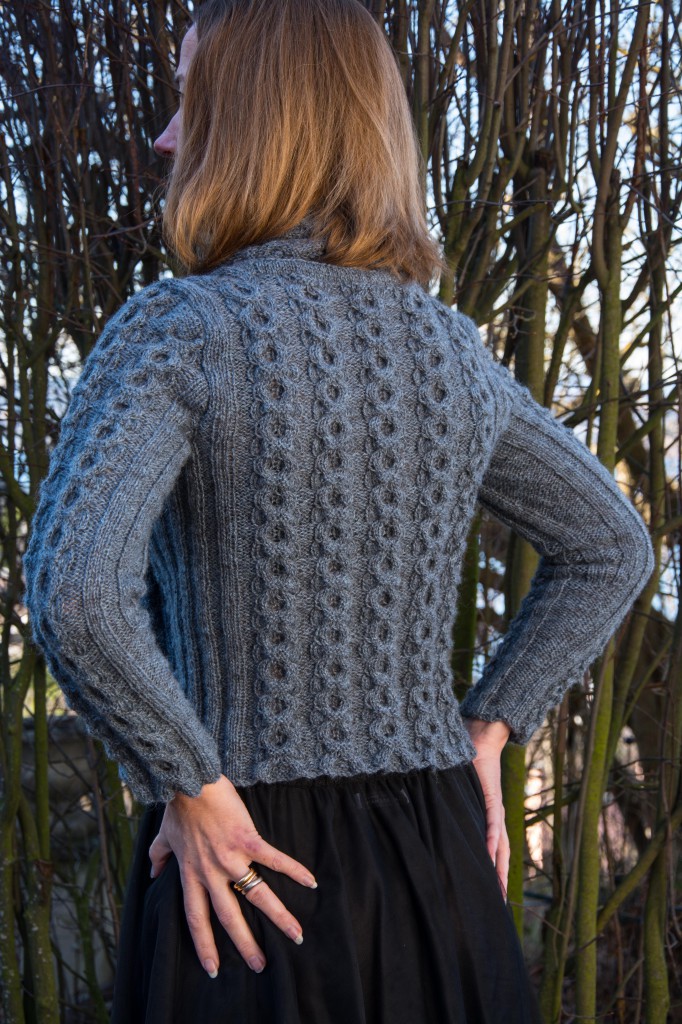 View from the back. I have a long back and long arms as you can see but both lengths can easily be adjusted to your preference. The neck band is picked up and knitted afterwards in stockinette stitch, with a bit of shaping and a folding line so that you attach it on the wrong side at the end. I co-operated with brilliant Re-design stylist Kristin Elise Halkjelsvik for Made By Me, and she suggested styling it with a pair of tight black studded trousers, a white mens shirt, an orange chiffon scarf with matching clutch plus we both agreed that Monica Stålvang Carmen boots in Petrol were perfect with it. Kristin also suggested beautiful orange cuff links by Siri Berrefjord. Below is a stunning picture from the photo shoot of Pia Cecilie/Team Models, hair and make up styled by Janne Skarpeid Hermansen, taken by Eivind Røhne.
View from the back. I have a long back and long arms as you can see but both lengths can easily be adjusted to your preference. The neck band is picked up and knitted afterwards in stockinette stitch, with a bit of shaping and a folding line so that you attach it on the wrong side at the end. I co-operated with brilliant Re-design stylist Kristin Elise Halkjelsvik for Made By Me, and she suggested styling it with a pair of tight black studded trousers, a white mens shirt, an orange chiffon scarf with matching clutch plus we both agreed that Monica Stålvang Carmen boots in Petrol were perfect with it. Kristin also suggested beautiful orange cuff links by Siri Berrefjord. Below is a stunning picture from the photo shoot of Pia Cecilie/Team Models, hair and make up styled by Janne Skarpeid Hermansen, taken by Eivind Røhne.
